In a small valley cut between two hills packed thickly with green trees, I sat ensconced in a wooden chair in the outdoor restaurant of my roadside motel. There, I supped on vegetable soup and “Transylvanian” Tochitură (a Romanian and Moldovan pork dish) with egg and polenta. As I waited to order, the man who had kindly given me a lift in his cart an hour earlier appeared. I translated the word for horse, cal, to ask where his was. He pointed across the road to a pen.

Brașov
I slept badly, soon giving up on quality sleep altogether and heading downstairs for coffee and breakfast pre-departure. Wolfing down a plate of eggs and ham, a middle-aged man struck up a conversation with me…in Romanian. Realising my obvious limitations in the vernacular, he sought common ground. “Français?” he asked.
I winced and made a face that said: “Ideally, I’d rather not”.
I offered, “Deutsch, German?”.
His countenance echoed my previous one.
“Espanyol?” he tried. It was settled.

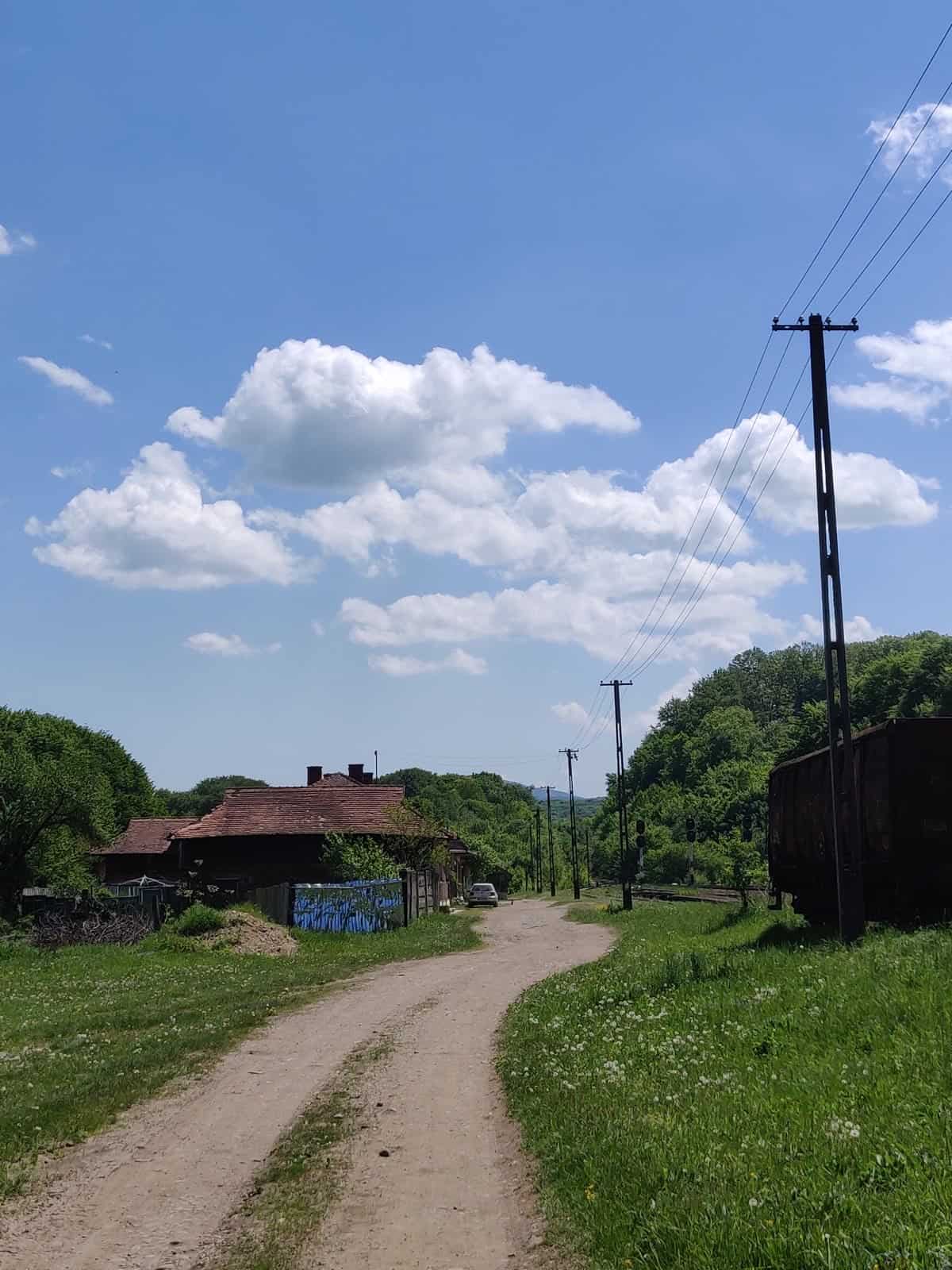
As I arrived in the outskirts of Brașov, in the mid-afternoon, I espied a handful of low squat buildings and hotels just above the old town, which sat nestled in the lower reaches of the mountain that towers over the old city. They reminded me of a cross between cabanas (though they were not remote), and – oddly – the sorts of seaside shacks where I would imagine mooring in remote Caribbean islands. Perhaps the heat and advances through tropical country were getting to my head!
I popped into Lidl and sat in the Central Park looking up at the mountains through the edge of the old town. On the hillside of Mount Tâmpa, which looms over the clay roofs of town, a large white sign displayed the name ‘Brașov’ in full Hollywood evocation. Having spotted the mountain and sign off in the distance a few hours earlier, I zeroed in on my destination.
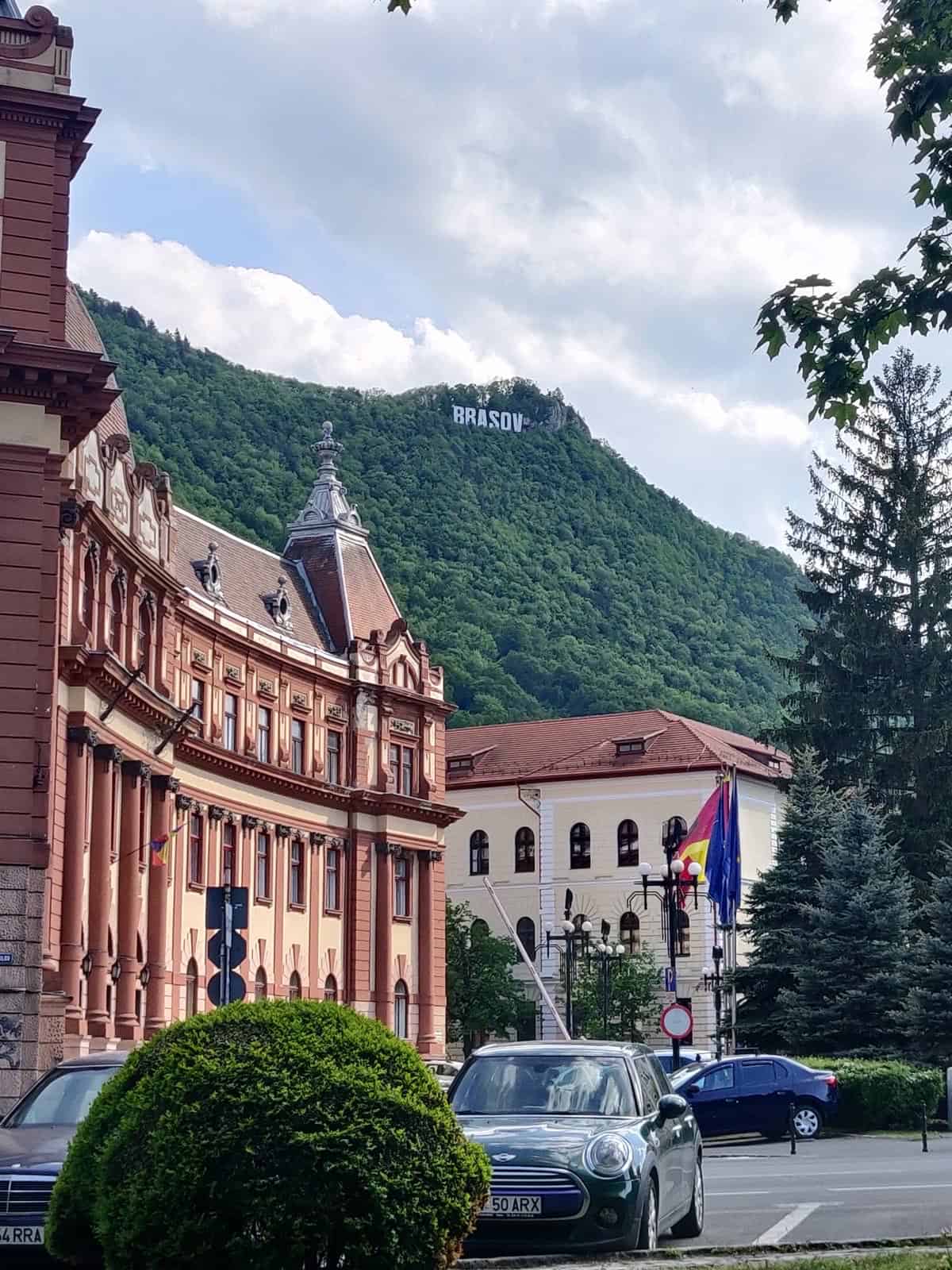
I checked into my hostel, which was down a narrow courtyard just off the main pedestrian street, Strada Republicii. My four-man dorm was on the second floor; it had the potential to be a party hostel (complete with a downstairs bar in the courtyard) though I soon discovered it was rather quiet and not too busy. I somehow ended up with a double bed in my dorm — a rare hostel luxury. Having run around town collecting supplies (baking powder, white vinegar (for my feet and shoes), more antiperspirant, toothpaste (the first I’ve needed to buy since Bavaria, I believe!), a new AC adapter (mine seemed to have given up on me), and last but not least a comb for my unruly beard!), I sat off the main square for a beer. Arriving back in my hostel, I met Shaun, a young Singaporean, taking part in an Erasmus-like programme in Barcelona. Together, we headed out for the evening.
Middle-ways
The next day, I rested and set out into Brașov to explore. I left my lodgings and the slim courtyard just off the main promenade of town to blue skies and warmth.

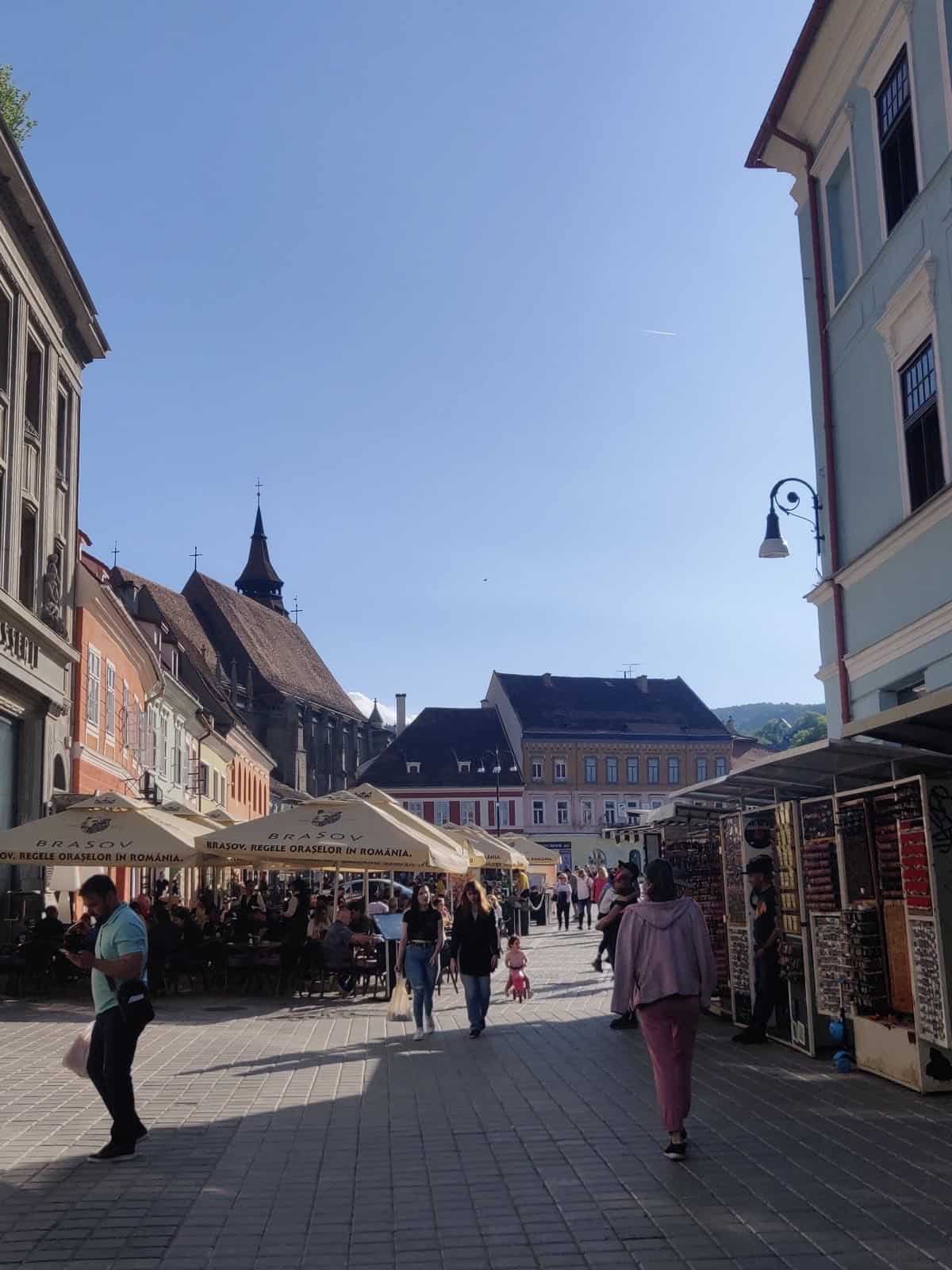
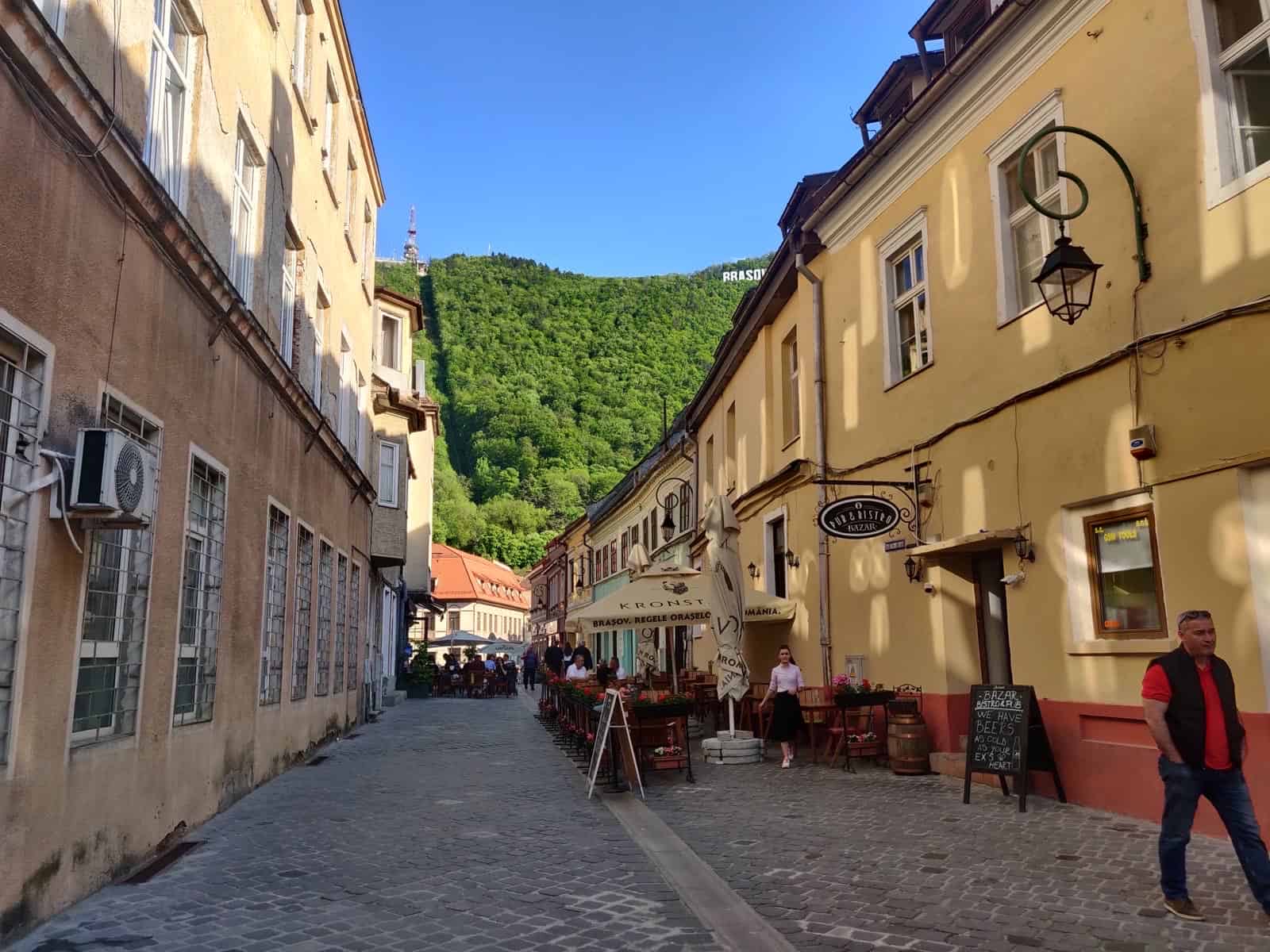
In Council Square (Piața Sfatului), I partook in a “Romanian breakfast”, consisting of cold cuts of cheese, ham, and salami, eggs, spring onion, and toast. I was adventurous with my first coffee that morning: I ordered a Café Roma, which, I thought, was listed as basically a cappuccino with almond extract. I soon realised the latter ingredient was a mistranslation of amaretto. It was only 11!

My initial section of sightseeing was in the Biserica Sfânta Adormire a Maicii Domnului, or, more succinctly, the Orthodox Cathedral. An orthodox façade sits on the east of the main square, and, through a covered alleyway, the cathedral sits recessed from the bustle of the square.
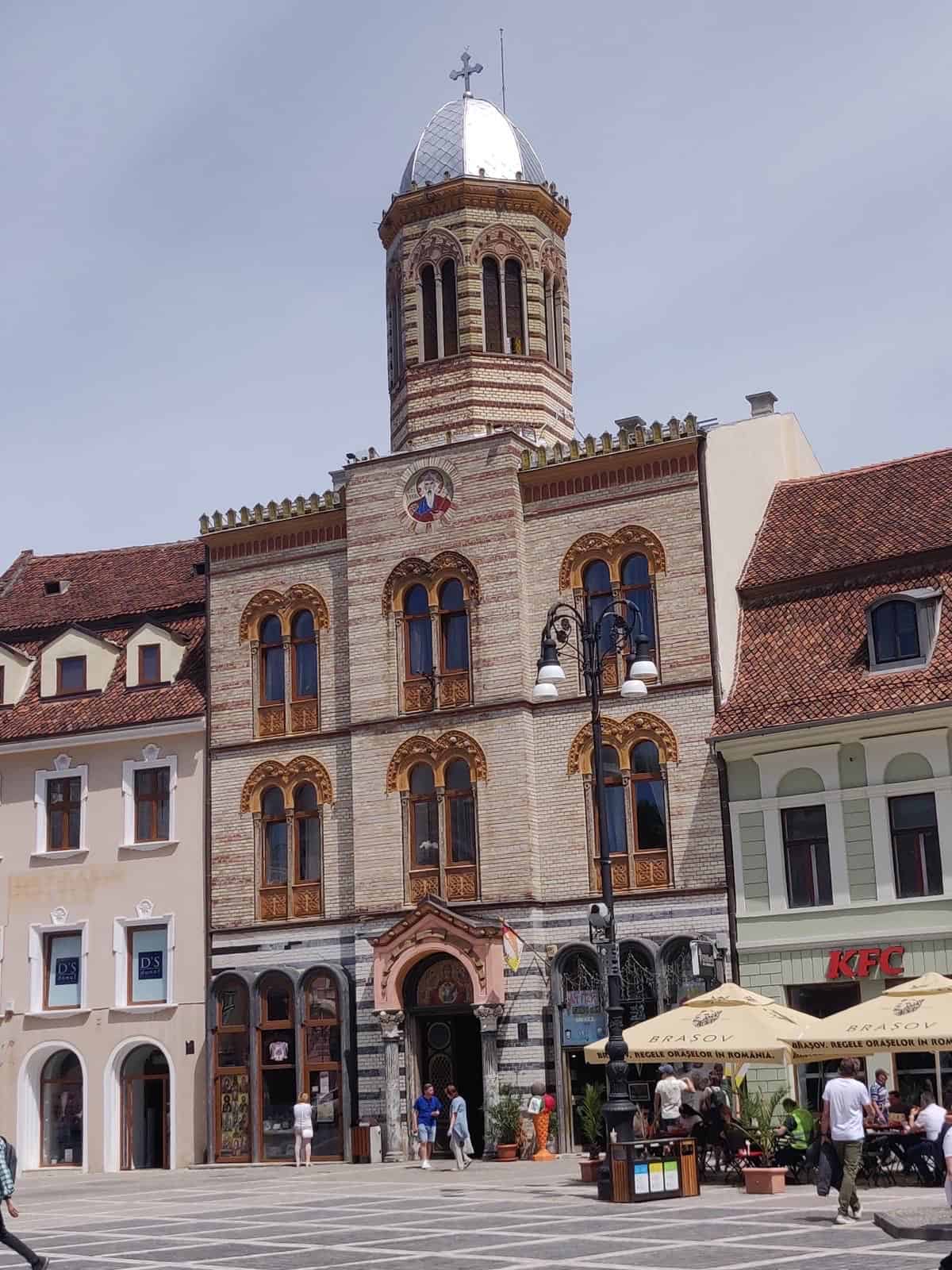
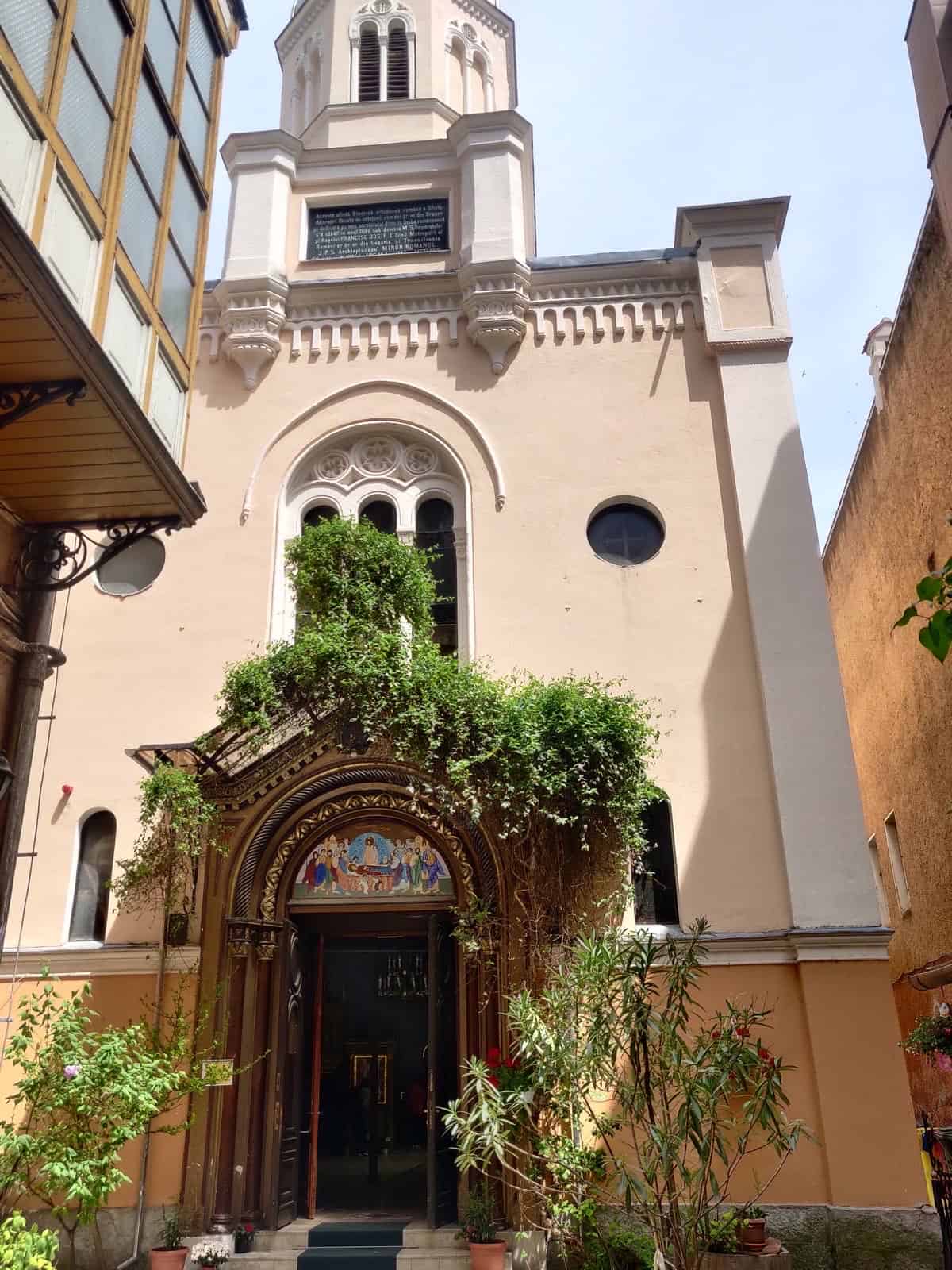


The Black Church was next, just off to the west of the central square; dark soot of centuries past had collected on the outside stone, lending the inspiration for its name. This was also, notably, the first Gothic church where I found a small entry fee was required for entry and potentially the first church of the whole trip thus far — I recalled how I had obdurately refused to enter the cathedral in Salzburg for exactly this reason. Though here, I relented. Within, the layout reflected a classic three-nave church. As Gothic churches go, it was remarkably very light and airy inside, in contrast to its dark exterior. A line of medieval Ottoman Rugs, collected by merchants around the 15th century, were hung along the south nave of the church and were also draped down from the side gallery. Brașov, or, to the Germans, Kronstadt, lay at an important crossroads on the historic trade routes connecting the Ottoman and Hapsburgs Empires: a real liminal space. The semiotic significance of these rugs, along with the forests and mountains without, imbued the church with a certain exotic character not found in Gothic churches of northern and western European spaces. It would be the last note of Gothic on my trip for a long while.


Not far from the Black Church, I strolled past the Saxon (German) school, Honterus Gymnasium, and on towards the Beth Israel Synagogue; it sat back from the road, down a wide alley. Passing through the various guild “portals” of town, I then looped back to the south of the centre, to wander around the old city walls, which lay largely intact in the shadow of Mount Tâmpa.

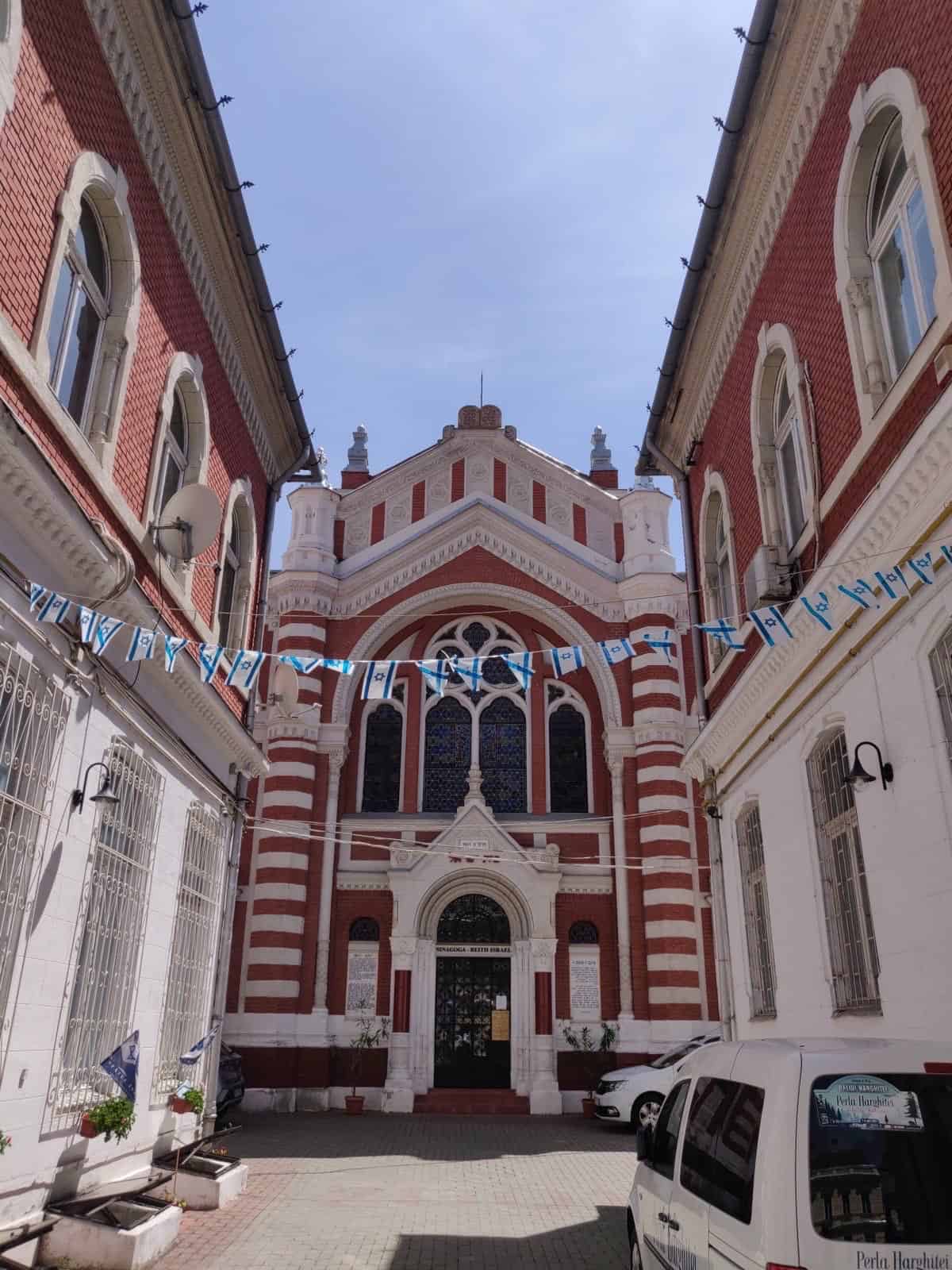
That evening the rain set in, and I took shelter just off main street, under the covered tarpaulin of a café. I noted how all the café rain covers of town alternate which name of town they display — Brașov (the Romanian), or Kronstadt (the German), or Brassó (the Hungarian). A cute touch. And, far above, the Brașov Hollywood sign had lit up, projecting out into the night the blue and yellow of the Ukrainian bicolour. I asked a waitress what it is normally illuminated in: red, yellow, and blue — the Romanian flag. A real beacon of solidarity shining from the Transylvanian mountains.
Later that night, when I found myself at a table with a drunk young man spouting Marxist ideology and eagerly enquiring about my experiences in Highgate cemetery, I bolted off down the street to bed.
The woods are lovely, dark and deep
Rain had fallen long into the night, leaving a cool, breezy overcast morning the next day: better walking conditions.
I had sketched a rough hiking route up and across the mountains from Brașov, where I planned to descend into the Prahova Valley, that I had so looked forward to reaching. First, I climbed up and out of Brașov to the west of the old town, scrambling up a steep bank nigh on vertically, before turning to enjoy the light-foggy vistas out over the town, from an abandoned orthodox chapel perched on an exposed ridge.
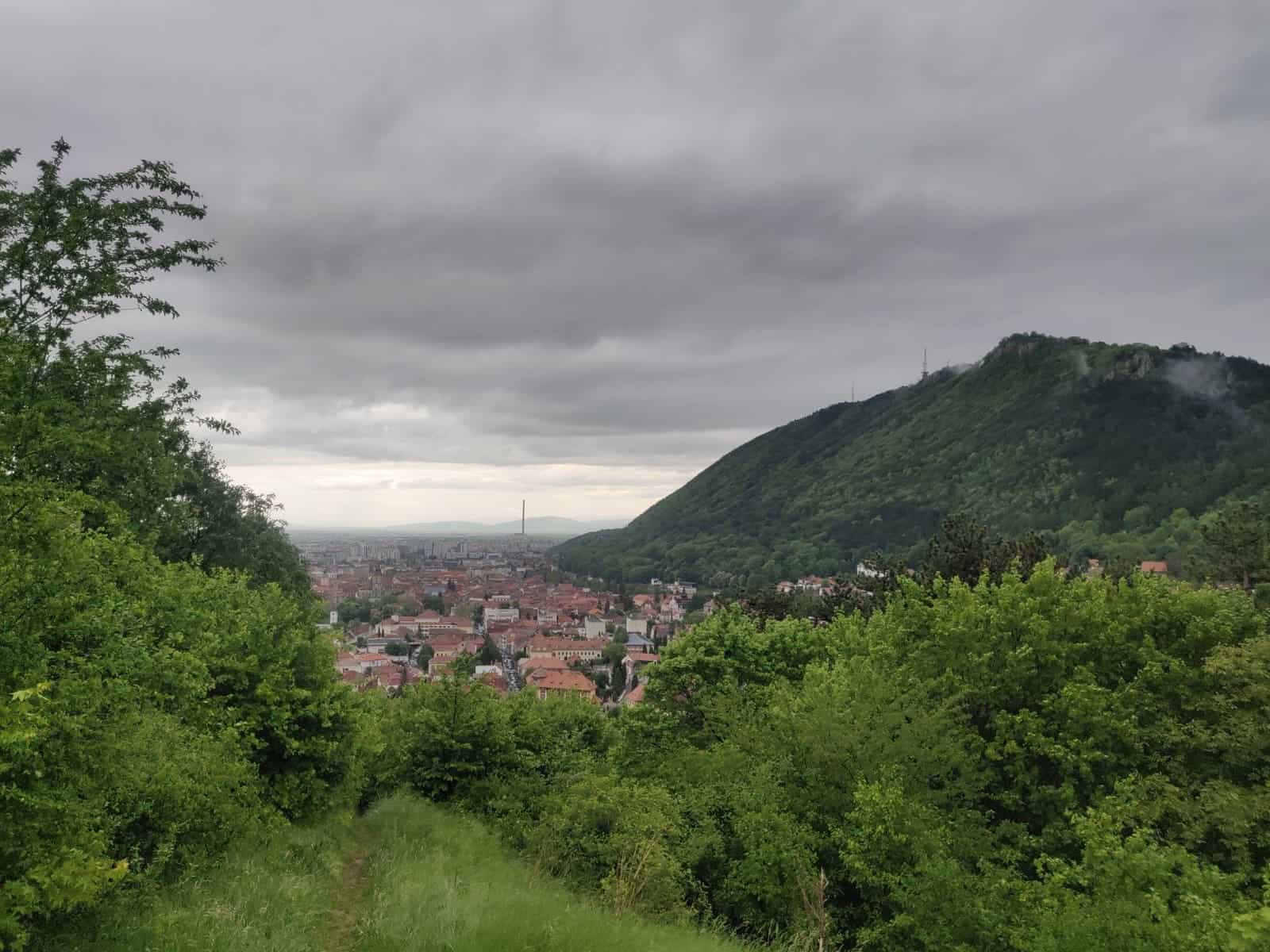

As I climbed and wound over the next few hours, the deciduous, almost-Mediterranean shrubbery soon gave way to pines, firs, and ever cooler climes. Soon, the ridge line levelled, and I spilled out over the Valea Sticlăriei, enjoying the flat of the grassy mountain fields and tracks. I was indisputably secured in the mountains, shrouded in turquoise clouds, with the odd smattering of dark grey.

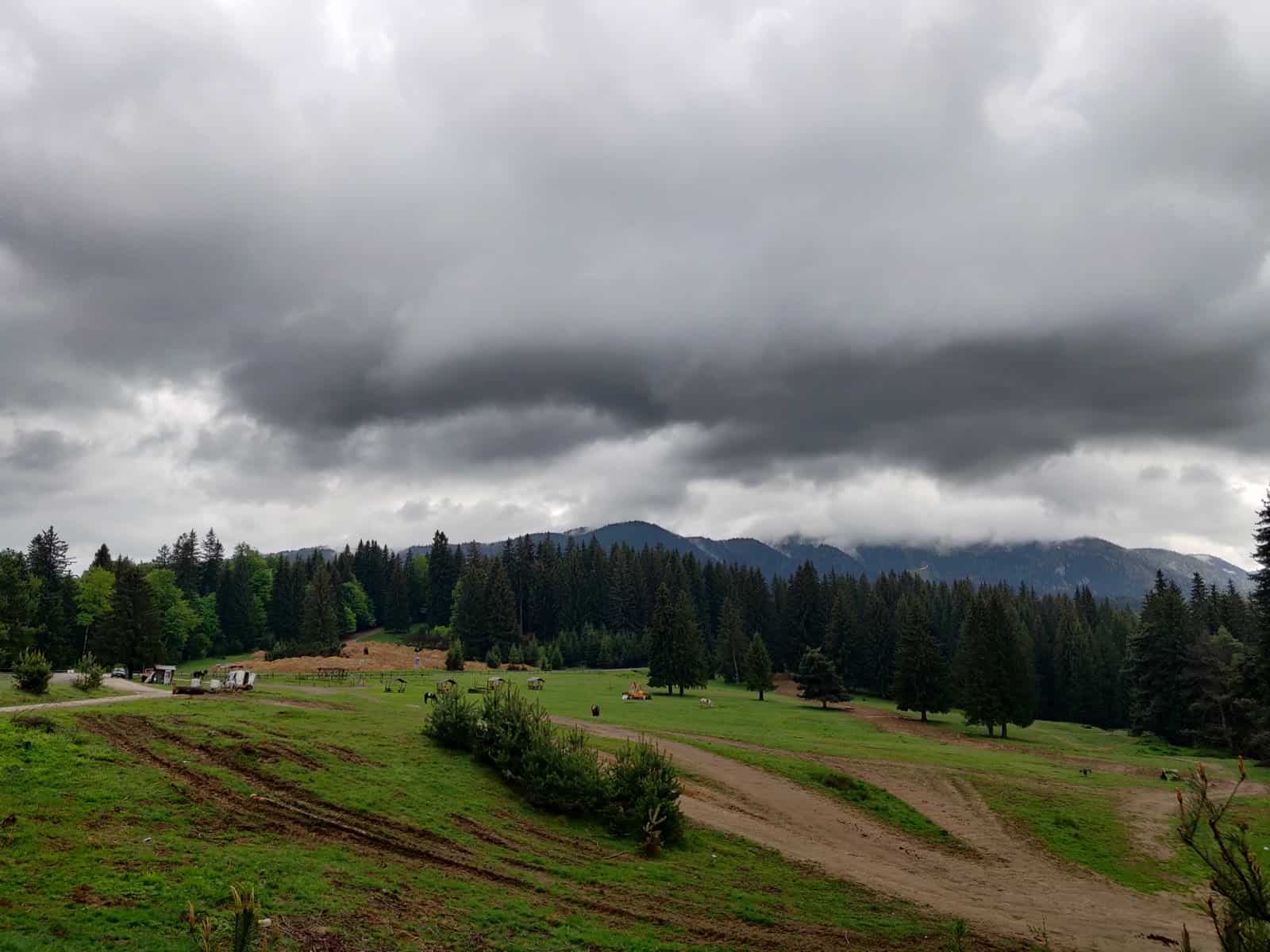

Hermitage
Soon, the valley narrowed, and I came to a stream of water, the beginning of the river. With no path now to follow, I followed the water.

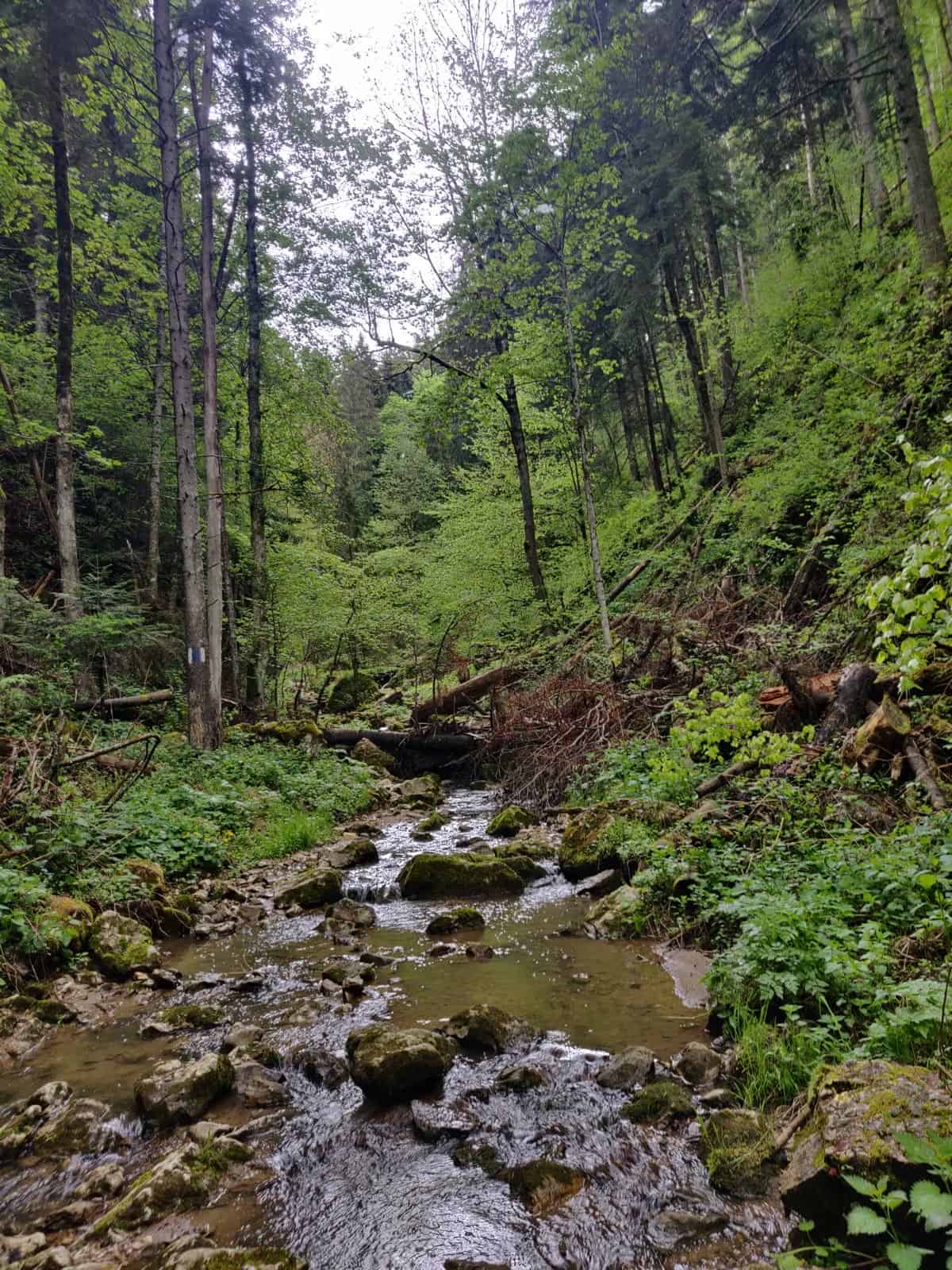
I hopscotched expertly over the pebbles which bejewelled the channels of the water — this puzzle-solving kept me busy. Progress was slow, but the landscape was lush and the waters refreshing. Even a slight tumble into the river had a rejuvenating effect. I bounded forth over the ravines.
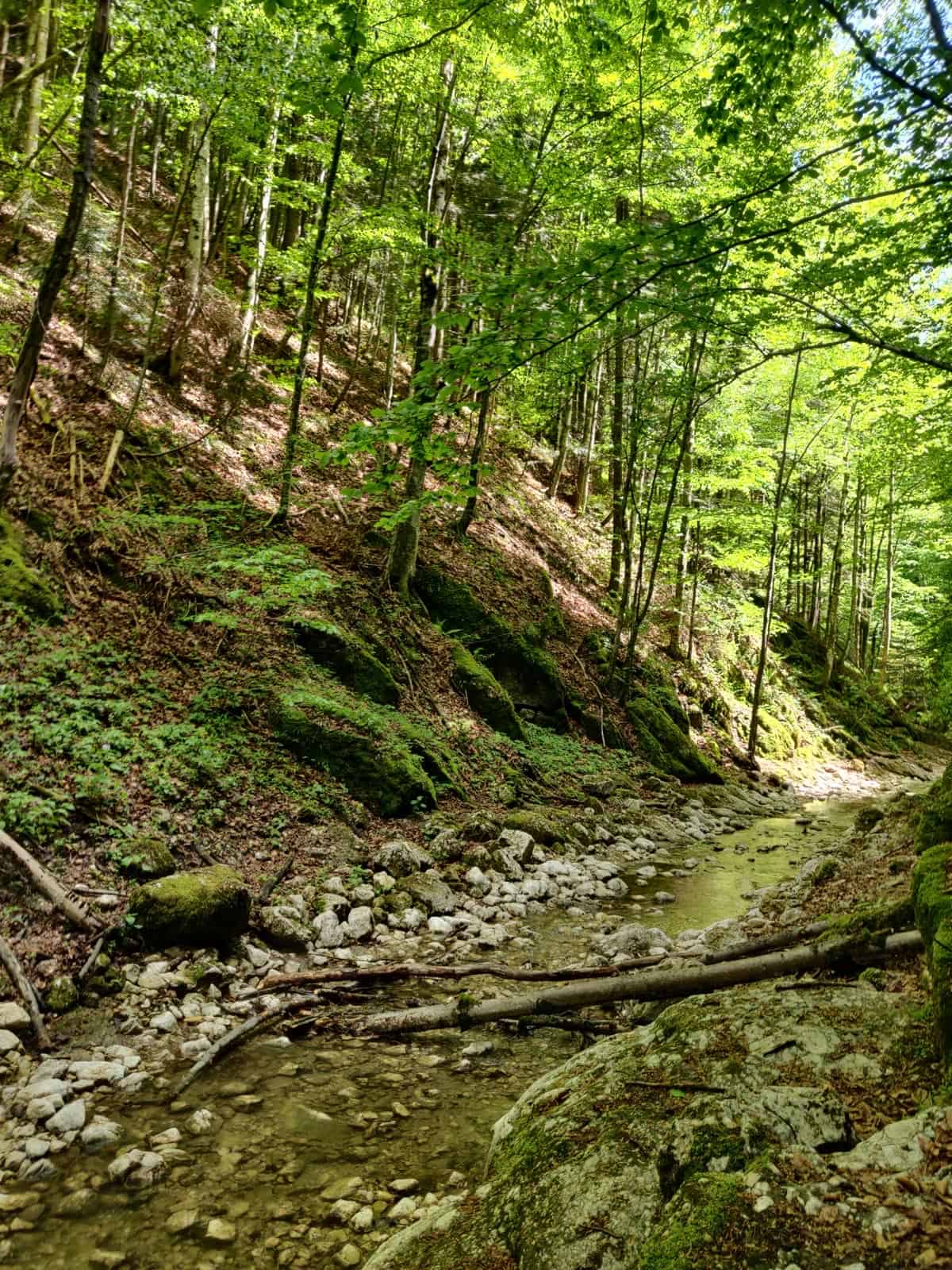
Initially, I hugged the steep wall of the valley, keeping dry, but soon I gave in to the occasion and necessity; I hopped down into the water, walking within and through the shallow stream which ran over pebbles and stones. The channel grew stronger as it ran its course. When I came to sections of rapid, or impassible sections of river, I often tried to hike up the steep valley banks and follow the course of the stream from the land above, all covered in thick shrubbery. I’d left any semblance of a forest path far behind.
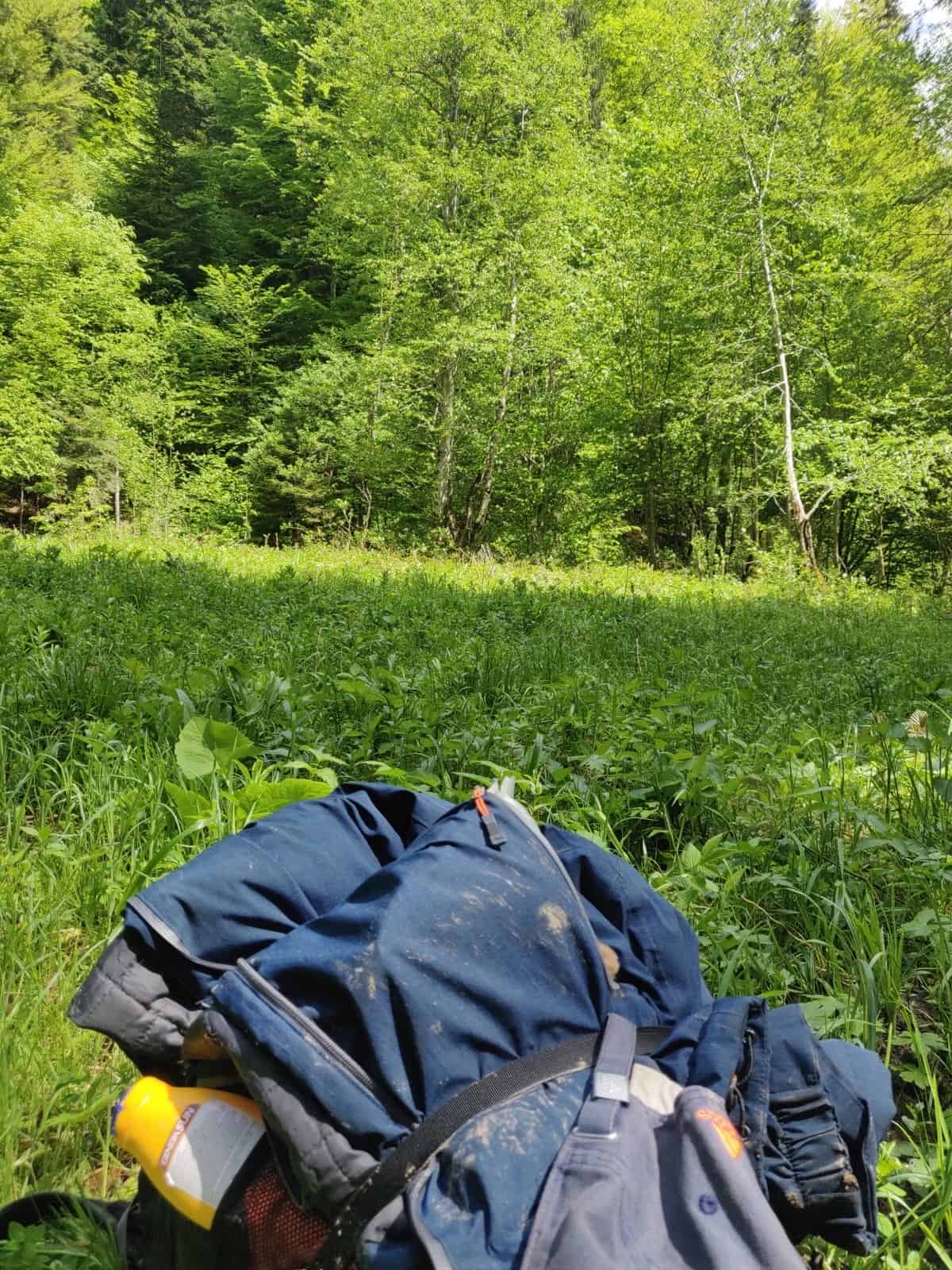
In the early afternoon, having been utterly alone and blissful in the mountains for some hours, I tried to descend back to the stream for the umpteenth time. I slipped and fell, tumbling down a shallow drop, through the mud and clay. I jarred my back slightly, but my pack, likely the destabilising factor in the fall anyway, happened to cushion my landing. Dazed, but also amused, I looked to my left where my hand had clasped around a stick thin branch, that had somehow stopped my full descent into the boulders below. Slowly, I scrambled down to the river below.
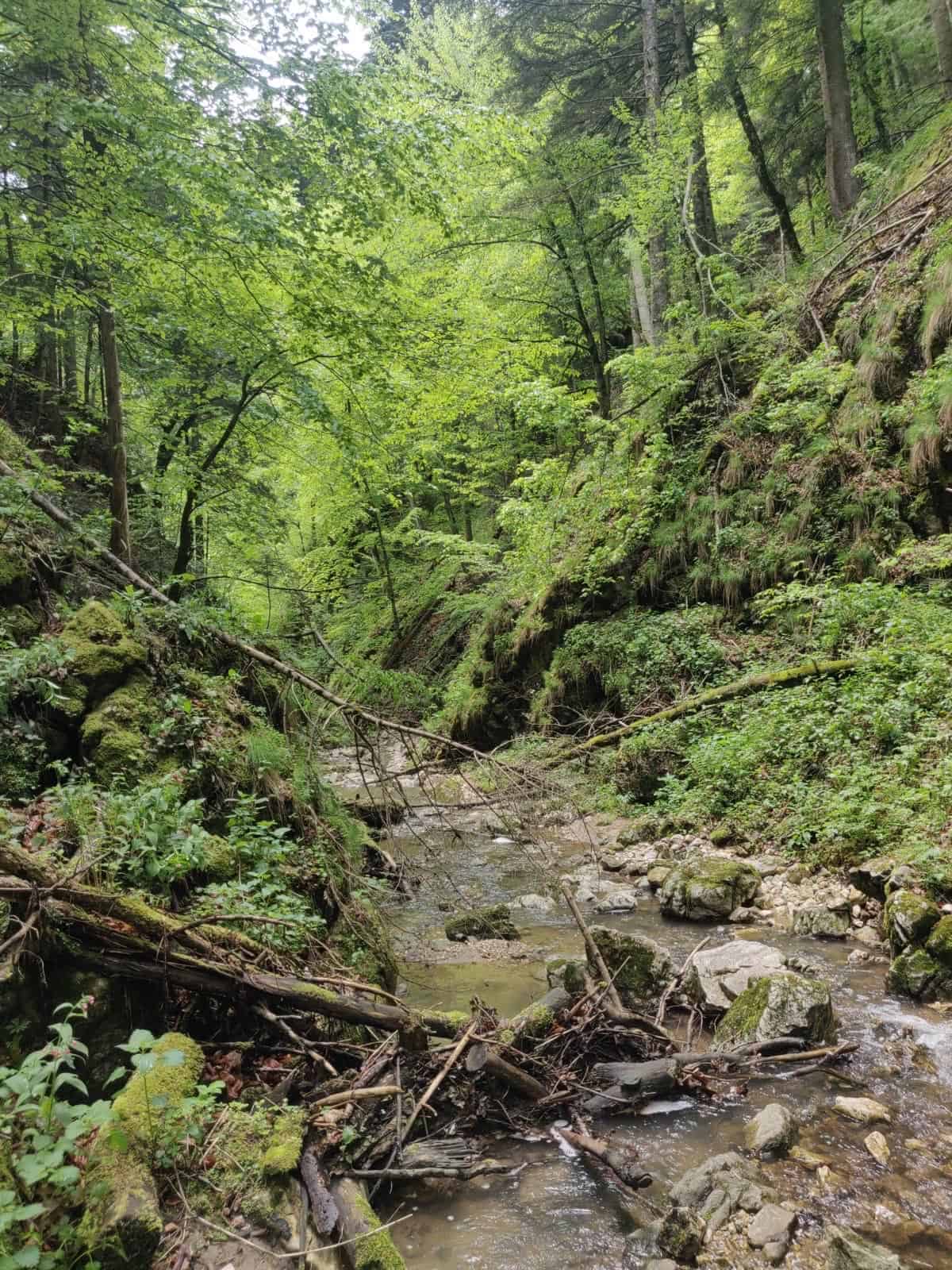
The skin on my of my knees and hands had been scraped away, leaving an ugly, blotchy mess in its place. I washed off muddied and bloodied hands and limbs in the river. And strategised.
Never stronger have I felt the calling to an ascetic lifestyle; I filtered the water from the stream, stripping off, I poured the ice cool water down my aching limbs. An icy warmth spread through my muscles and sinews. I made a rough-and-ready salve from dock leaves and antiseptic, using a twig and a flat slab of bark to mortar down a paste, which I applied liberally to my hands and knees.
Then I drank from the waters.
Climes
After a time, the narrow valley around the stream (at this particular juncture named Valea Poienii) and the dense trees, opened up into a wider way. The dappled sunlight through the canopy roofs made way for the strong Romanian sun and blue skies which had emerged on the other side of the green tunnel. There had been a chill about for much of the day – cold for the first time in a while – but by now the sun had once again emerged, and layers in turn were shed. Seeds blew out in front of me, flying horizontally from the shrubbery which lined the dirt path I had stumbled upon, onto which I had emerged somewhat bemused. Higher mountains with snowy peak appeared off in the distance. I came to an open field with three mares grazing by the path. I stroked the snout of a dark brown mare as two brown eyes gazed up at me.

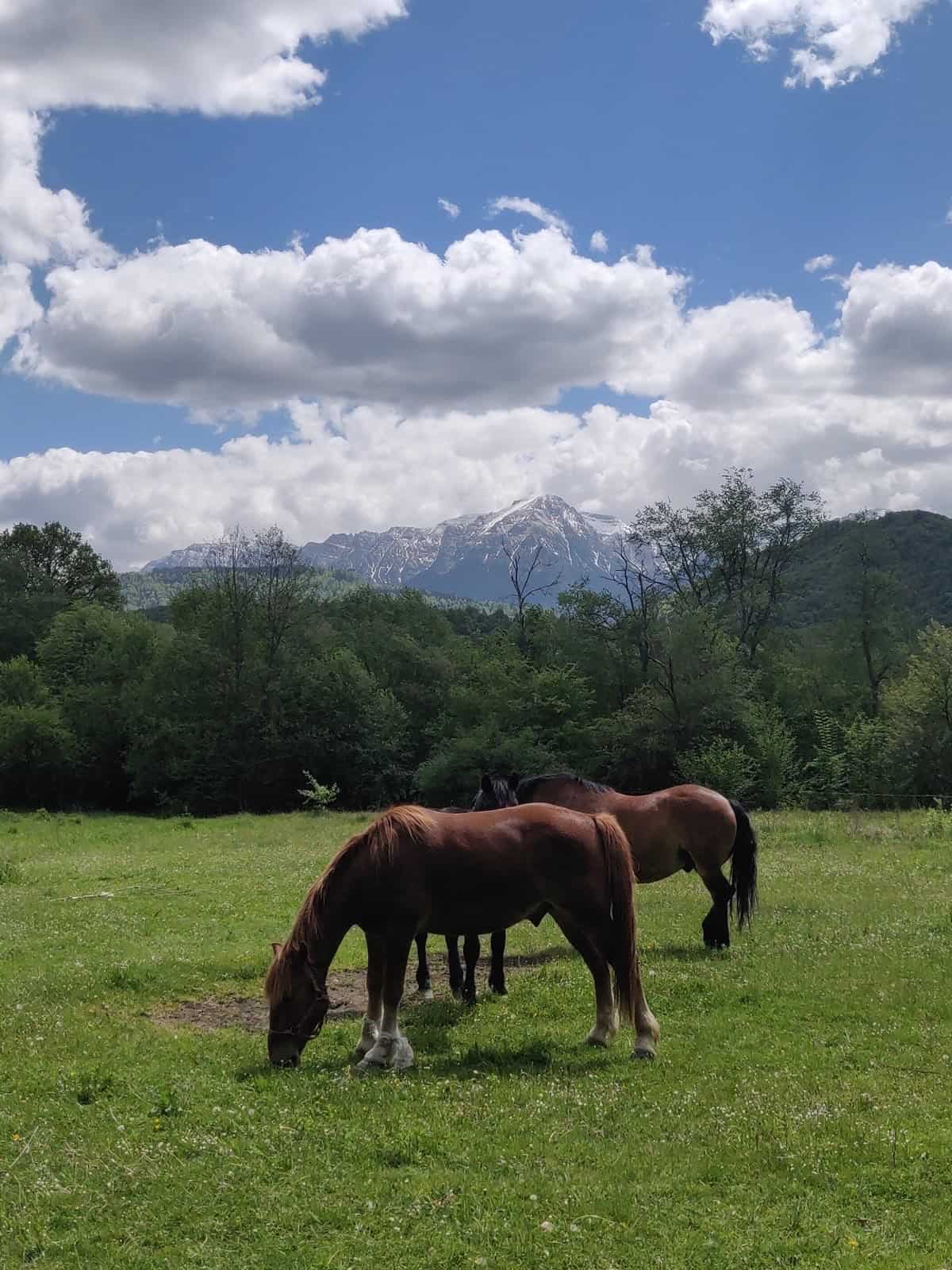
A minute later, I passed a sign on the path into where I had just spent the last five or so hours. The sign read: Conservation area for the Romanian Brown Bear. Take caution.

After refuelling, I turned east, re-entering those similar leafy, river-focused, valleys. Faded signs informed me of a route through Valea Lungă and then Valea Tocilitei: the path lasted no more than 50 metres before giving way to soil and the imagination of the traveller.

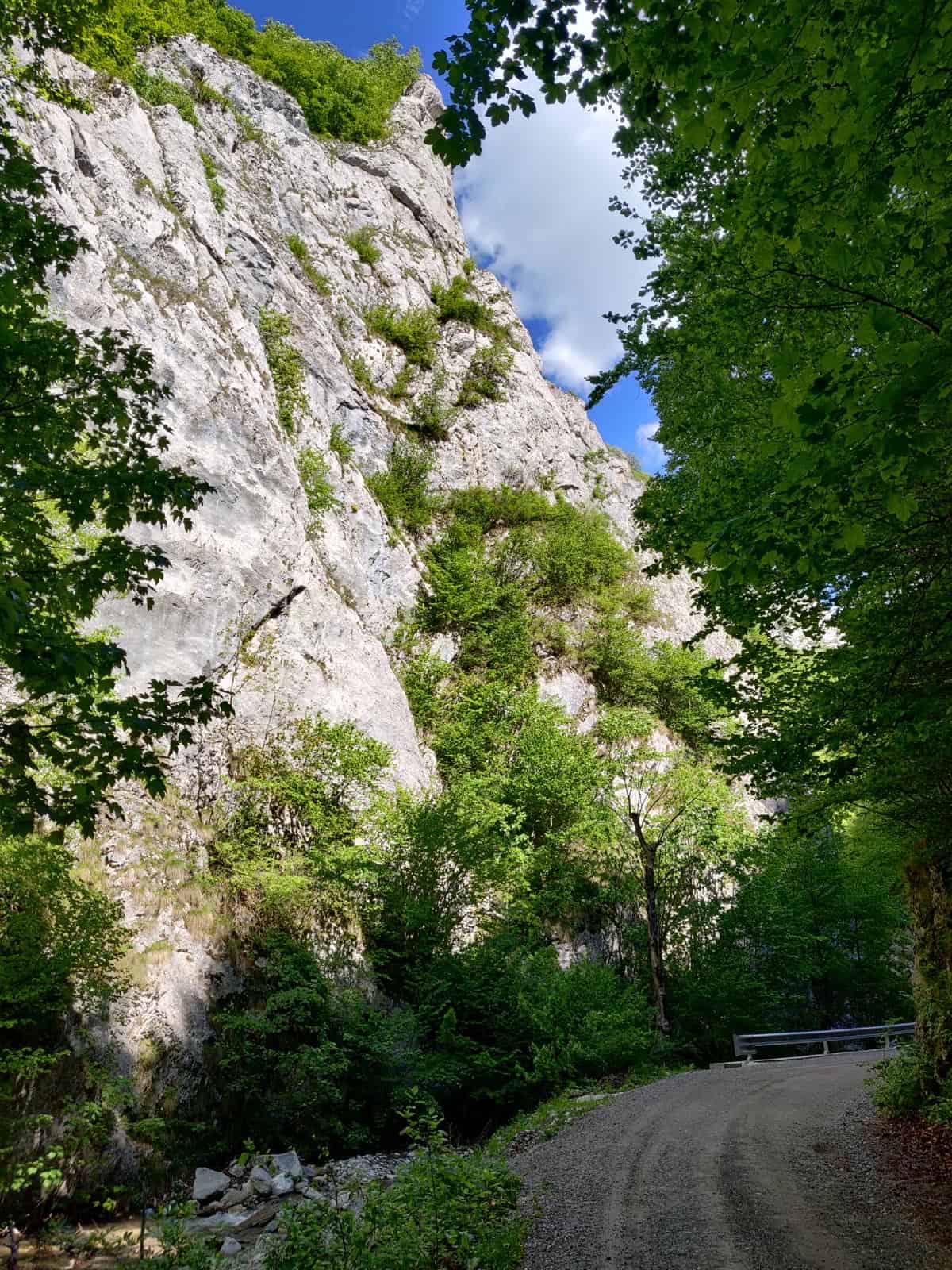
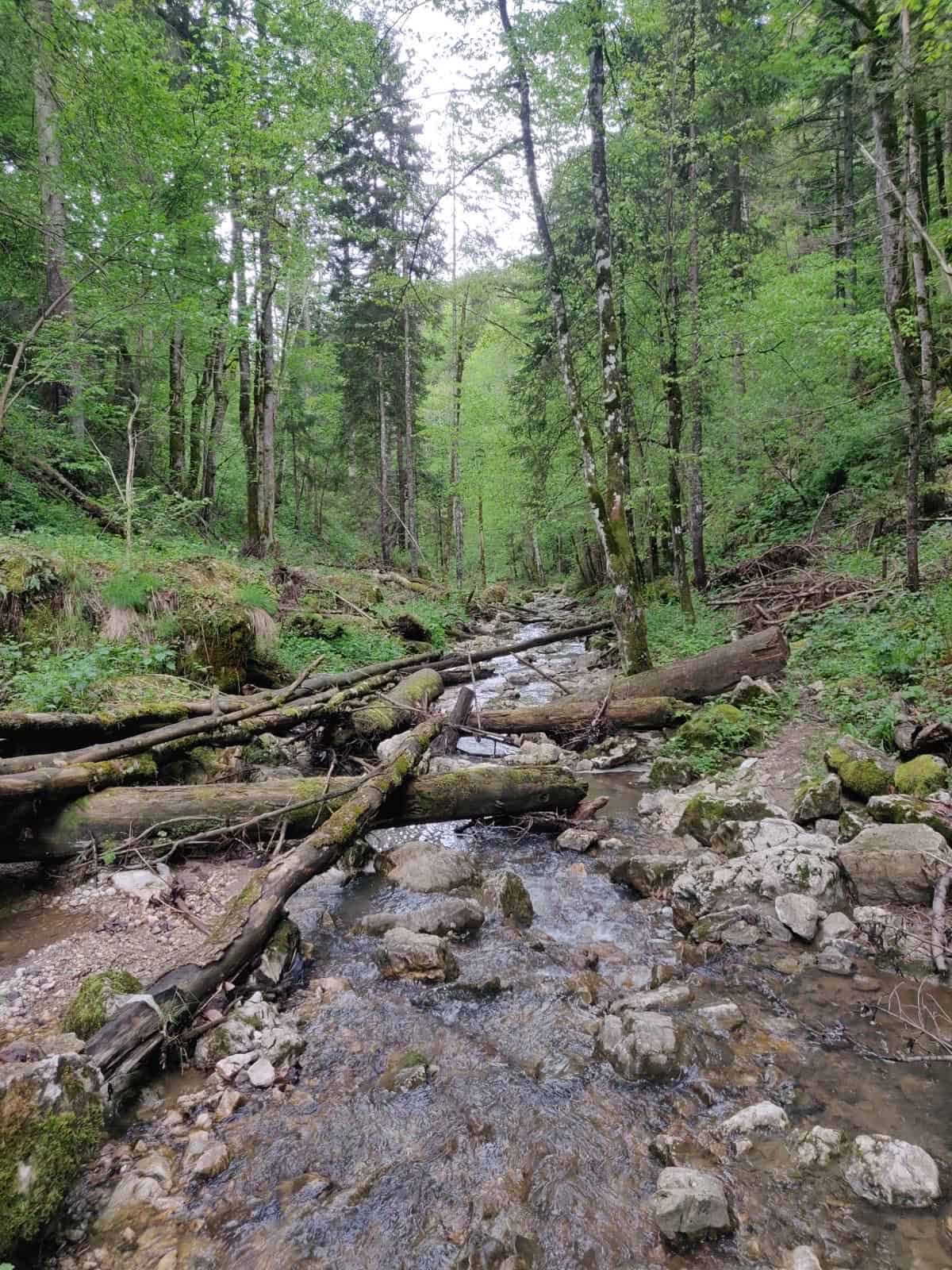
A couple of hours of tough climbing on soft mud ensued. For a brief instant, I thought I espied the silhouette of a lone wolf in the shrubbery above me. As it turned its maw in my direction I blinked, and the apparition was gone; confused and alert I trudged off — apparition or not, where one wolf prowls, the pack is sure to follow.
Hues of the valley
Eventually, I rose out of the valley to a breathtaking view back over the peaks of the forest. Dark green hues were spread, interspersed within a lighter shade of far-off branches and leaves, and stark mountain cliffs lay just behind. All around the hues of green and blue shone with brilliance, as if drawn to the surface by the occasion — in my experience, a key characteristic of spring and summer in the Romanian mountains.

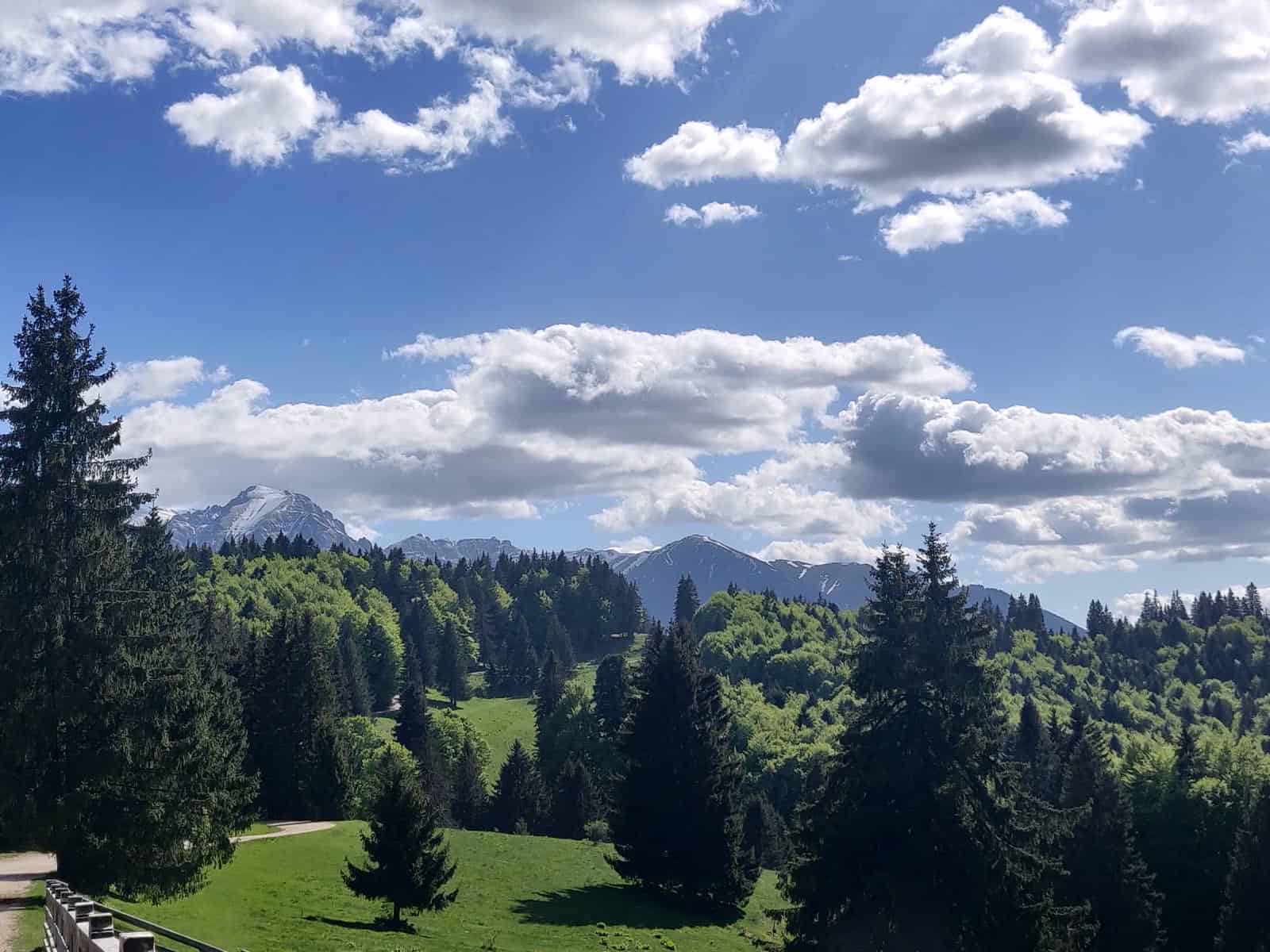
I spotted a series of wooden lodges ahead of me as I made for the mountain road that I would eventually follow to descend into the Prahova Valley and my day’s destination, Predeal. Stopping at the last one, I sat outside for a moment, drinking in the “summit”. The momentous muzak escaping from the lobby within was amusing, but failed to cheapen the moment — one of serenity and contentment.

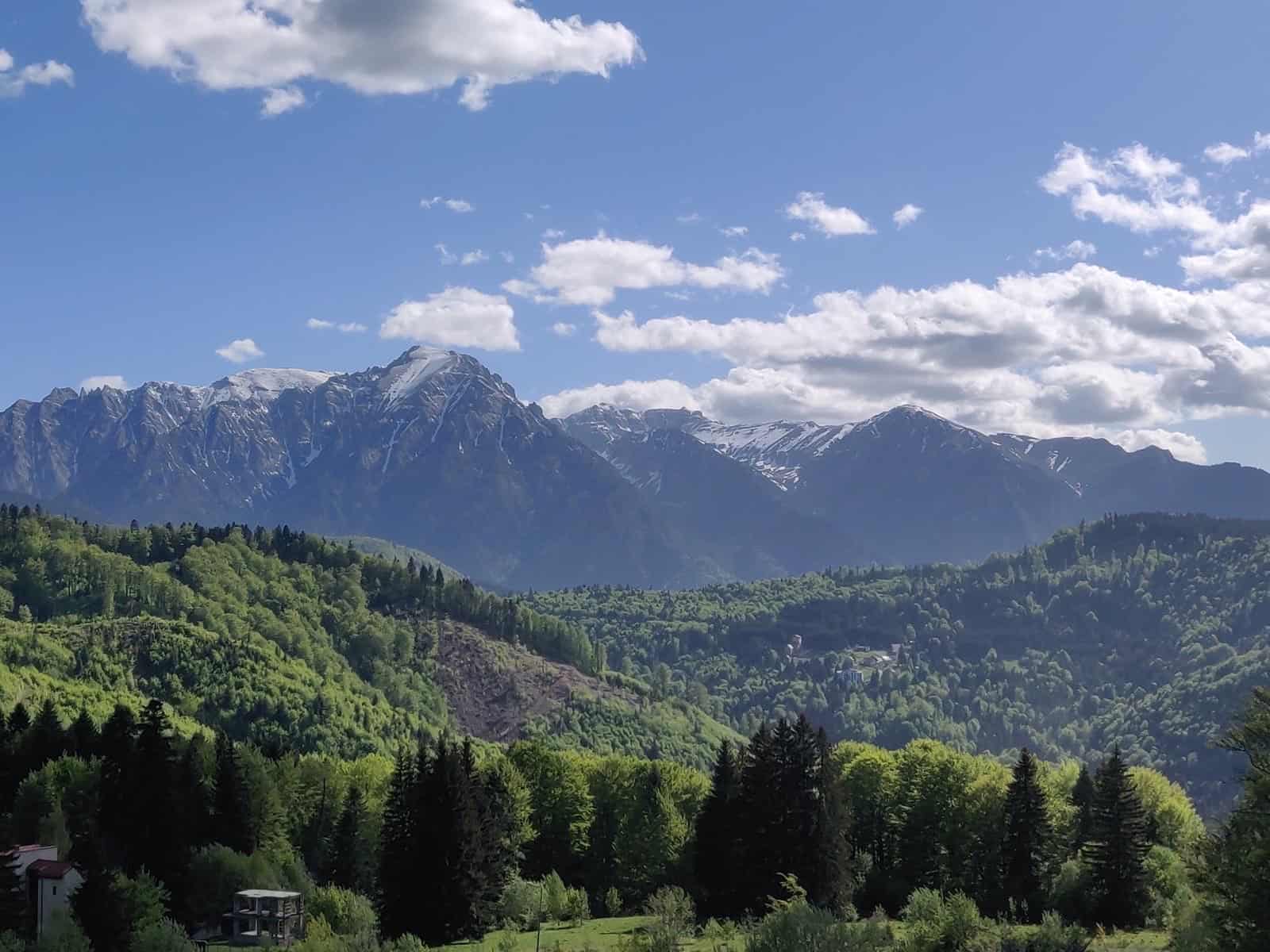
The Bears of Predeal
In the late afternoon, with the sun still high in the sky, I descended from the Bucegi mountains down into the famous Prahova Valley. There was now no doubt that summer had arrived; that “summery Koblenz feeling” had settled in for what felt like perpetuity — the longest summer of my life.
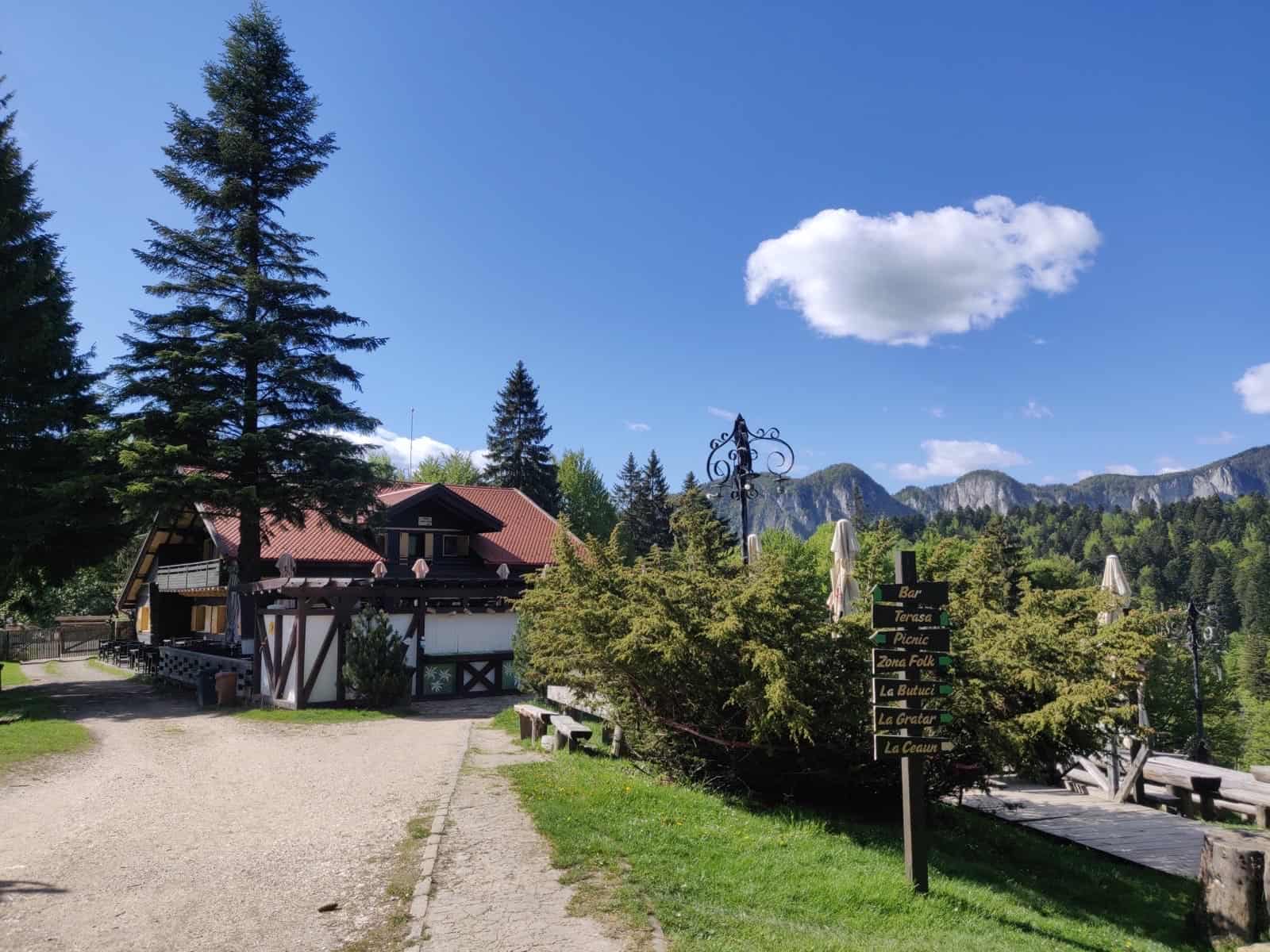
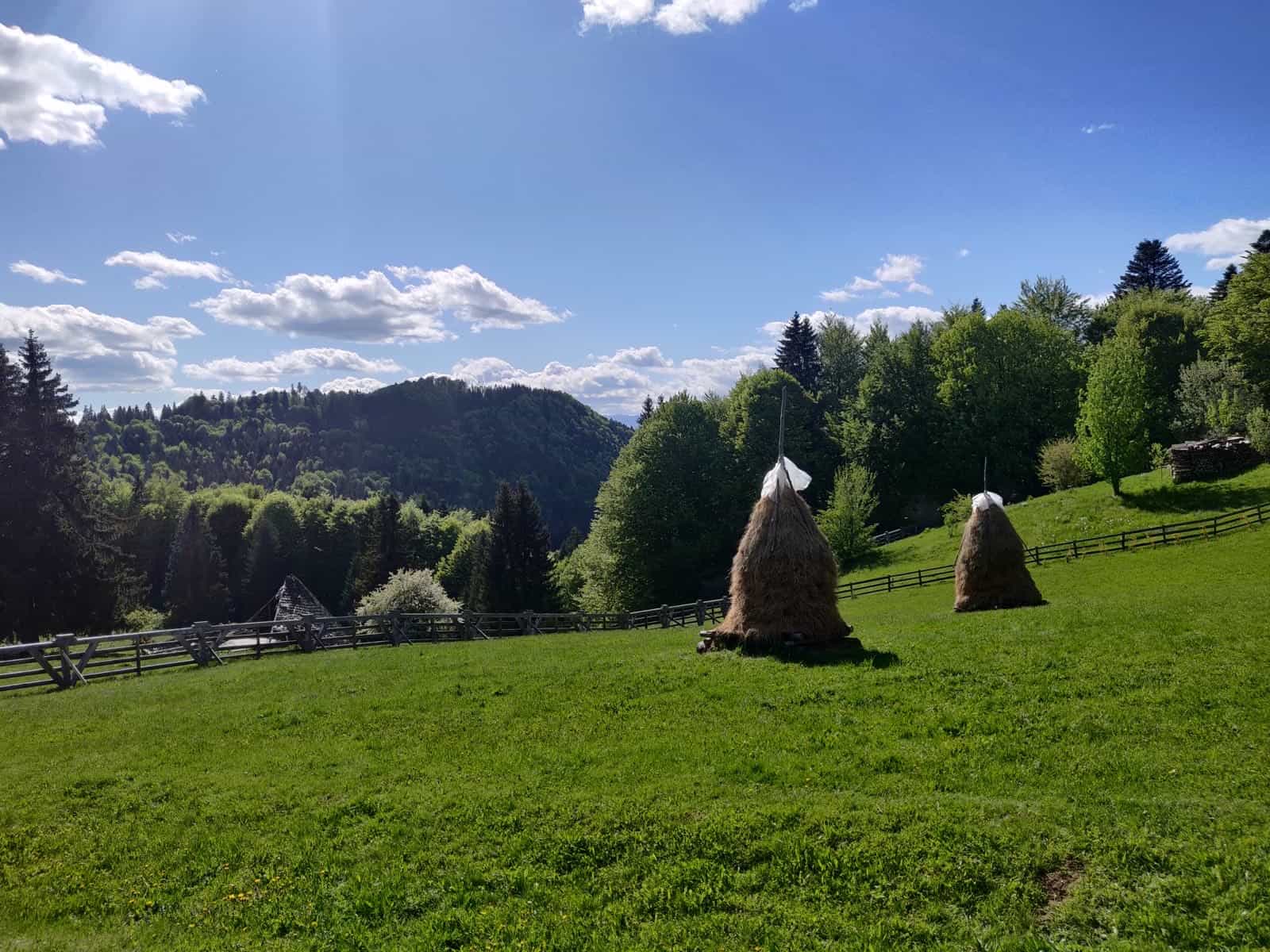
In town, a police convoy of around 15 trucks passed me by, each carrying tanks dressed in artificial leaves of camouflage. Predeal is a ski town, so felt slightly abandoned and empty for my out-of-season visit. A Romanian school friend of mine had kindly made arrangements for me to stay in their family chalet that night, so it was there to which I trudged as the sun began to set. Speaking German with the guard on the gate with the key to my apartment for the night, I was warned me not to stay out late as there are often bears roaming the streets after dark. (When I returned that night, I received an emergency phone alert warning me to stay inside as a bear had been spotted a few streets away! Fortunately, I had just returned to the safety of my abode, else there would have been great dramatic irony to a scene involving me standing to the side of a dim mountain street, attempting to translate a warning of the presence of a beast only several yards behind me — I doubt it would have done me the courtesy of waiting for the Google Translate app to load before making its move on me. No, no, after you.)
Absolutely knackered after a wondrously anadromous day of cadence and seclusion, I collapsed into the bed of a wooden lodge and dreamt.
Prahova Valley (and the Castles therein)
After a short lie in, recovering from the aches of the day before, I set off around 11am having planned out a relatively less strenuous albeit equally rewarding day. I had reached the Prahova Valley, and I was elated. The valley connects the historic regions of Transylvania, to the north, with Wallachia to the south; it cuts through the Bucegi and Baiu massifs of the Carpathians, joining Brașov with Ploiești, not far from the Romanian capital just to the south.
I walked along the main road which ran through the valley for about 40 minutes, before stopping for a sandwich and coffee at a roadside petrol station, much to the bemusement of the workers stationed therein. Not long after, I continued along the road, hugging the dusty edges of the cracked tarmac. I passed a garden where an old man, wielded a 3ft long, curved scythe striking down the weeds before his house with veteran precision — though I had seen industrial blades used in the fields of rural Hungary and Northern Romania, this was the first usage I had seen of such technology on the domestic stage.
Making good time, I took shelter off the road for a while in a cemetery I had glimpsed, climbing into the hillside amongst the woods. There, minute, chalky-white crosses lay in rows, petering off into the ridge above.
On the other side of the town of Azuga, the mountains loomed ever so large, hanging over the town and valley. They appeared especially craggy at this point, with much of the rocky girth uninhabited by greenery, exposing the crevices and ultimate fissility of the great cliffs.
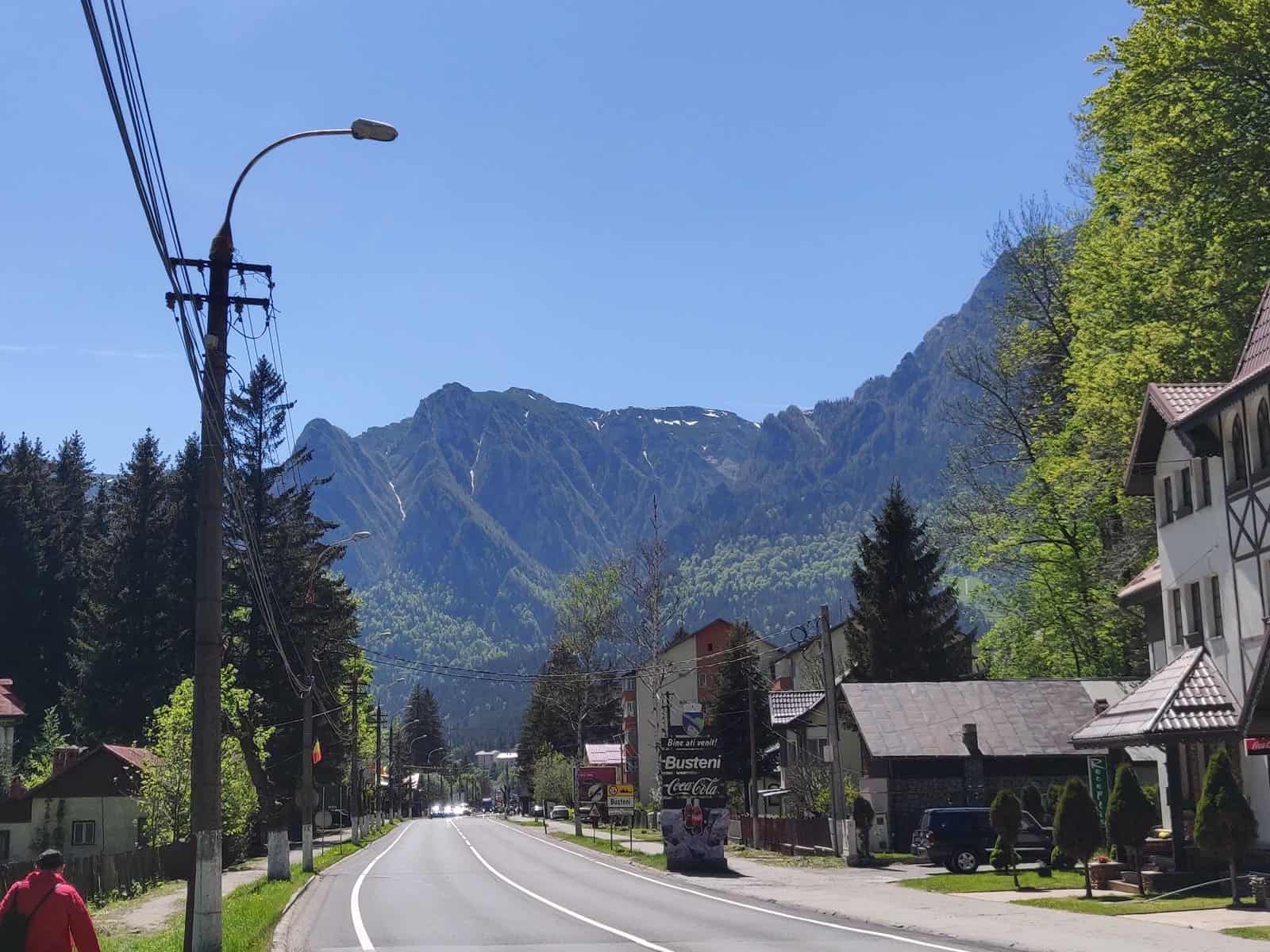
Cantacuzino Castle
By the mid-afternoon, I had arrived in the town of Cantacuzino, the first castle-bearing town of the valley. I ascended from town and confirmed my suspicions: tours were in Romanian only. I walked around the grounds, gardens, and courtyards, taking in the architectural nuances, but most of all its context: set in the foreground of towering hunks of rocky mountains. The last remnants of the winter snow were slowly melting away high above. The valley was stunning. The brilliance of the sun’s rays cast angles of dusty mist across the rocks and down onto the forests below, the massif towering over all. Peaceful and calm.



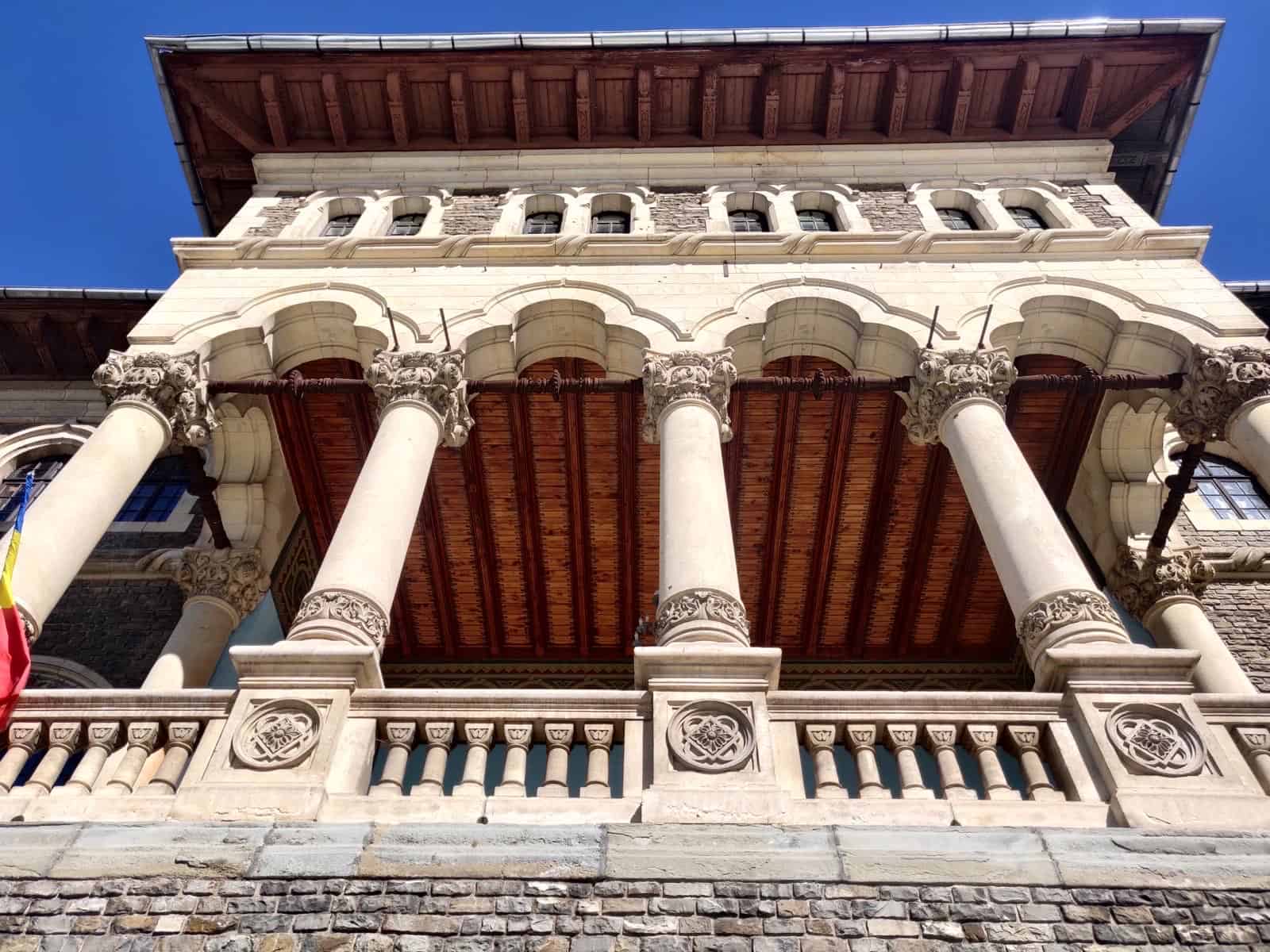

That night, I stayed about 20 minutes from the castle, on the top floor of a narrow guesthouse, which sported an odd barrelled hot tub outside on the terrace, that seemed permanently occupied by the owners or their friends, as they sat around drinking beer. My room’s window sported no pane or panel, just an open view of the snowy peak opposite.

Unorthodox routes
I rose late in the morning and a busy day of castle seeking and touristing lay in wait, but I had a plan: the night before, I had inspected the maps and decided it possible to approach the great Romanian castles of Peleș and Pelișor from the mountain valley, to ascend into the forests, follow a ridge trail and draw up to the palatial peaks in the middle of a clearing, and then descend to blend in with the crowd. Once the seed had formed, my nighttime dreams had sealed it.


After a while of searching and ascending into unmarked and unpathed woodland, I discovered a hiking route along the western ridge of the valley. Ambling through the forest, I paused upon occasion on the uncollected logs by logging camps, soaking in the bird song. I located The Queen’s Trail, which took me up to a narrow cobbled trail half-eaten by the forest. Soon, the tunes of the birds were accompanied by the growing murmur of voices…and the hammering of restoration; I was near.

Descending from the cobbles over the rise of a small hill, I made my way towards Pelișor, the last working castle and royal residence of the old Romanian royal family.

Pelișor
The castle was rather elegant, and less boisterous than it’s older sibling that I had caught sight of briefly and would visit next: a timbered castle completed in 1902 for Ferdinand of Hohenzollern-Sigmaringen and Marie (granddaughter of Queen Victoria and the cousin of Tsar Nicholas) — the heirs to the throne.
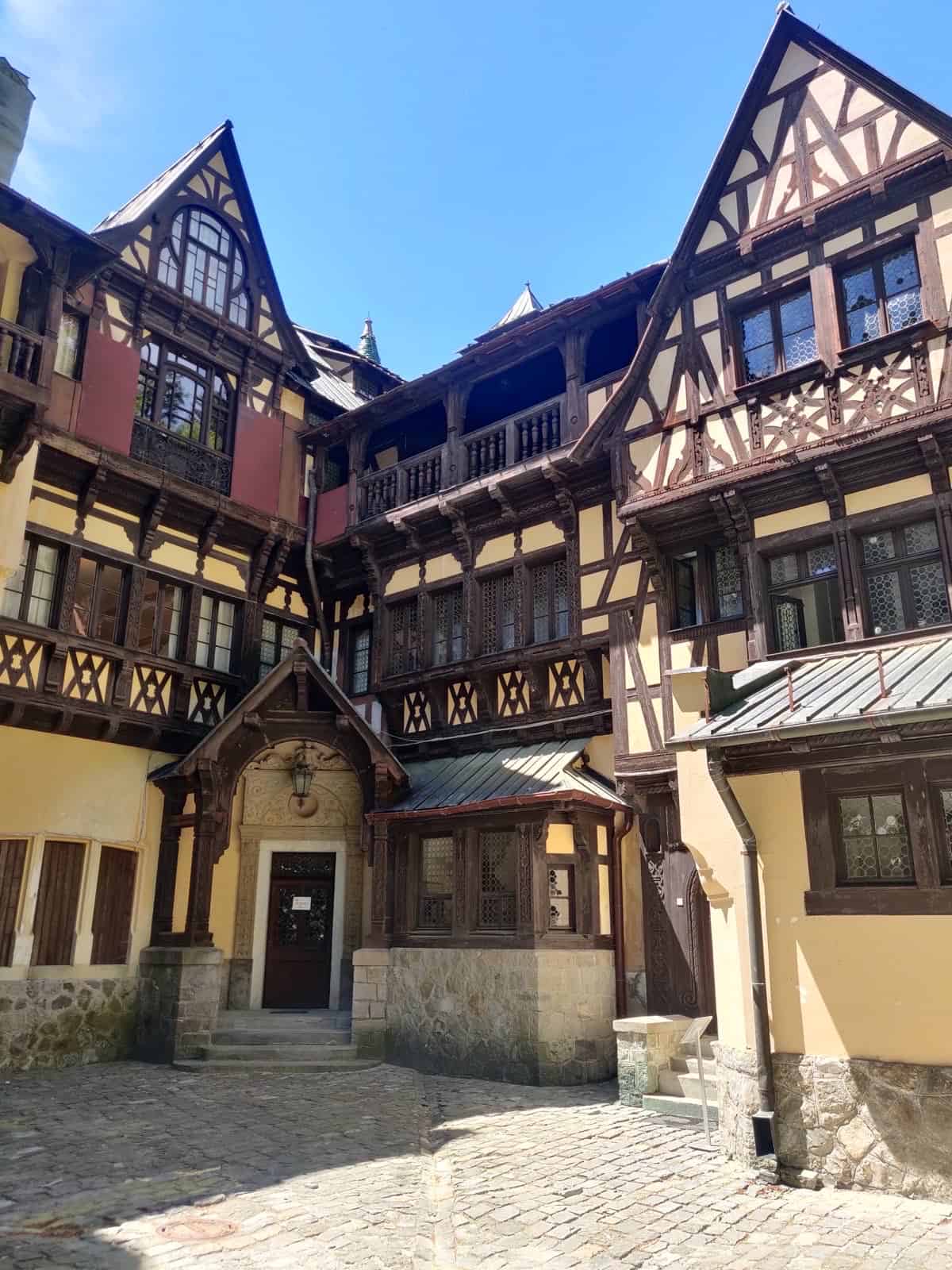
I entered into a hall filled with light oak panels and fin-de-siècle stucco. The spaces were light and airy, lit by led-rimmed crown glass windows (of both stained and clear varieties), and also a skylight which hovered above the main staircase.
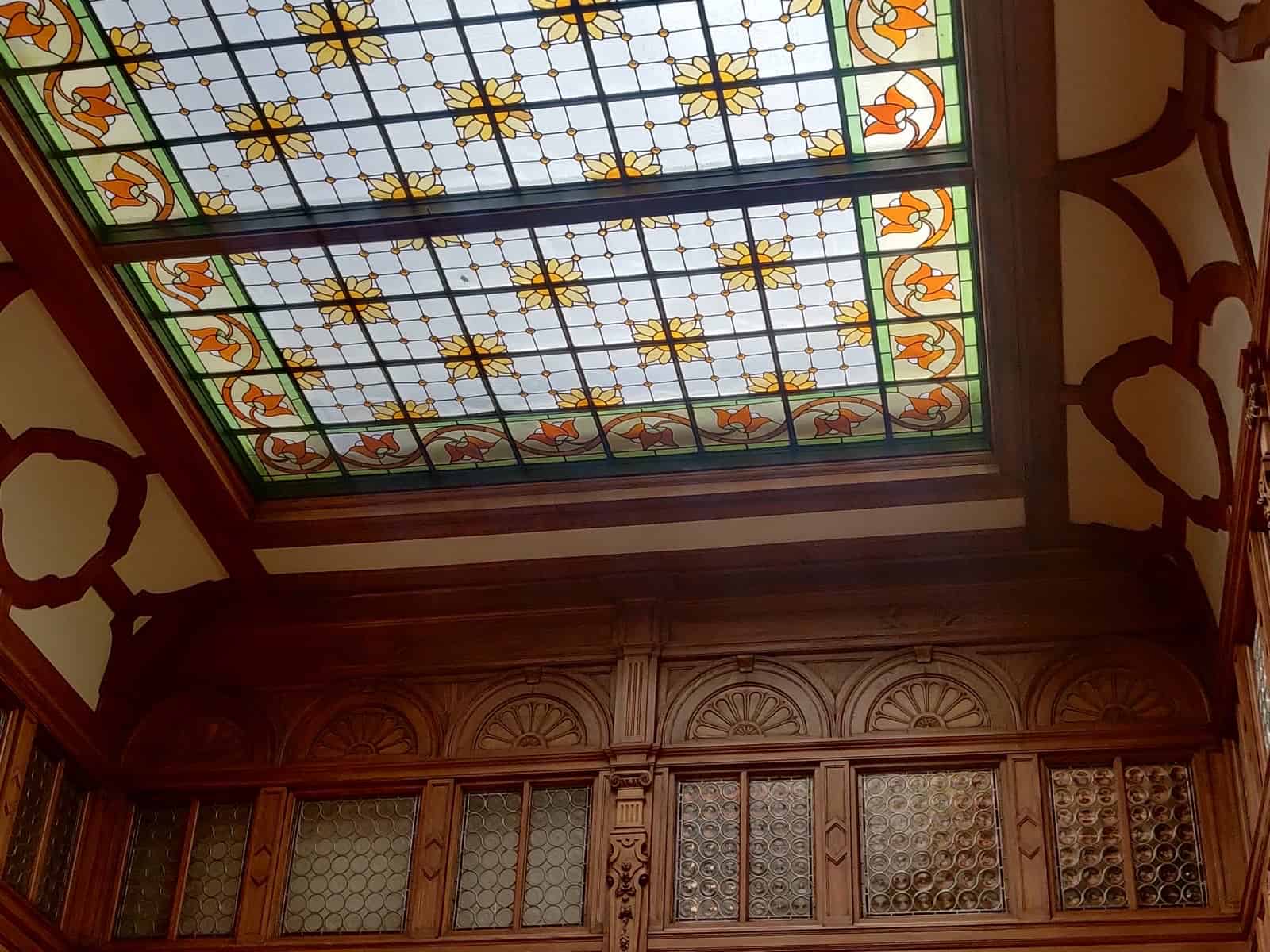
The interior furnishings and embellishments were the real captivating element of Pelișor: Queen Marie’s unique style comes to the fore, in an endearingly eclectic mix of Celtic and Byzantine elements packaged in an Art Nouveau vision. The signage and museum information makes the case that the internal decoration was largely of Marie’s own conception and thus a reflection of her aesthetic values, her brilliance as an adopted Romanian. It’s a sweet narrative. Many of the rooms are rather smaller and maybe more austere than the classic image of royalty and palatial spaces (though my tour of next door Peleș, would yield the opposite impression!). This is more of a reflection of an operational palace built at the turn of the century; artistic developments (such as Marie’s pioneering of her very own blend of Art Nouveau) were allowed and encouraged as a reflection of meaningful development, but perhaps overly grand and large-scale workings of the past were no longer quite as acceptable, nor were they required.

On the desk of the sitting room lies a portrait of Tsar Nicholas, Marie’s cousin, and his son Alexei.
Peleș
Next up to bat, just around the corner, was an icon of Romanian heritage — perhaps, along with Bran castle in a neighbouring valley (the supposed setting of Dracula’s castle per Stoker), the icon of Transylvania and Romania.
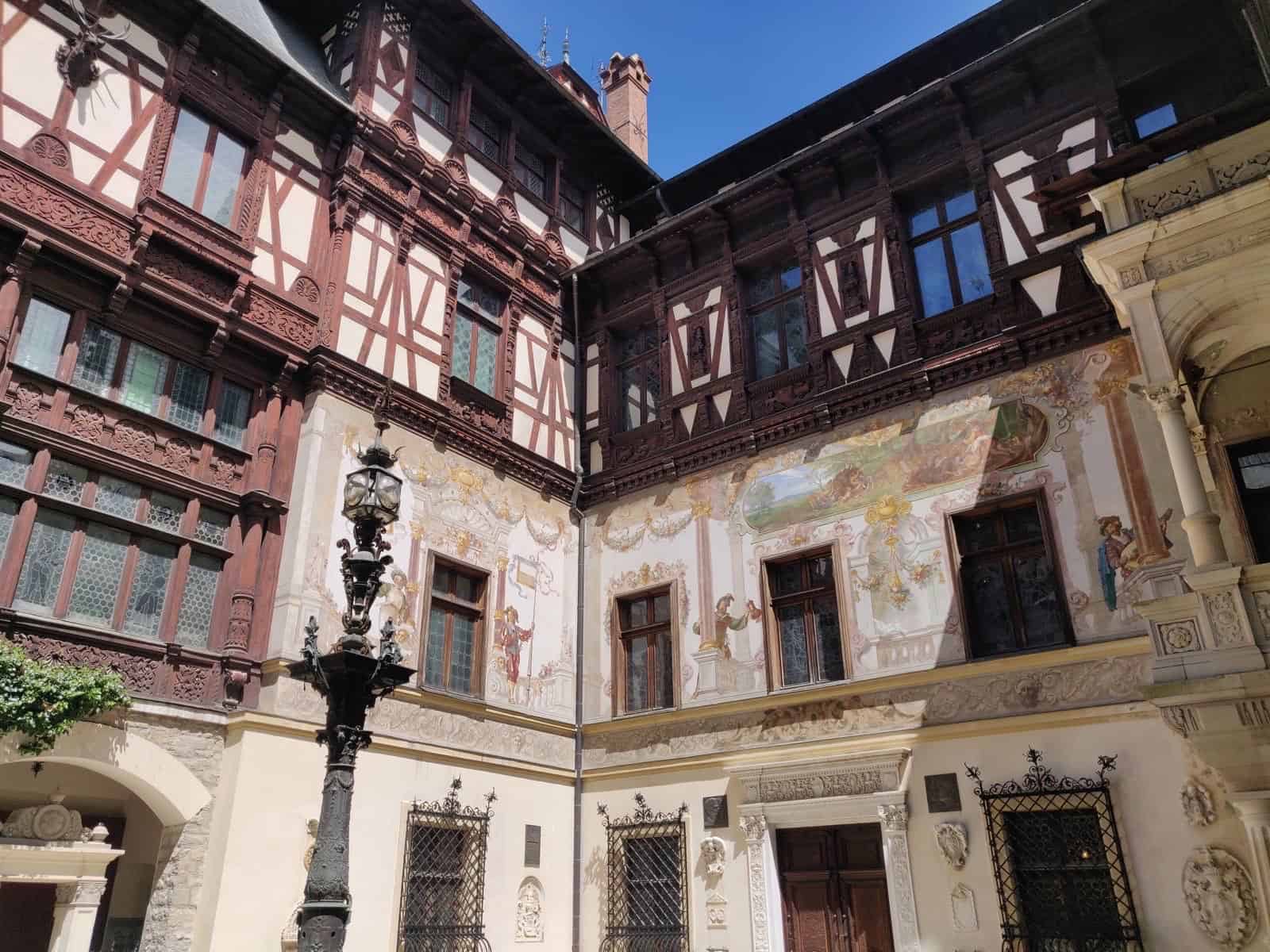
Peleș served as the summer palace for Carol I of Hohenzollern-Sigmaringen, first king of Romania (1866-1914). It was built between 1873 and 1914 in a German, Neo-Renaissance style, and fitted with central heating, running water, electricity, and a landline at its very inception. At the entry of the central hall, overtaking the odd tour group, I was overcome with excitement. This was my kind of mountain palace: walnut wood and relief everywhere. Every room played off a different style, theme, or historical theme — a playhouse on the grandest of stages. Despite its overarching presence, both within and without, there was a wide range of other, non-Germanic, neoclassical styles. They were stereotyped in the most lavish and brilliantly executed fashion: an Italian Neo-Renaissance throne room filled with white marbling and Venetian craftsmanship; French-court hallways; Turkish low carpets, cushions, and geometric stained-glass; Moorish gold-plated stucco mounted on panoplies, with a Carrara marble fountain at the rear. I was lost in a quaint hodgepodge of high-quality craftsmanship and syncretic taste.
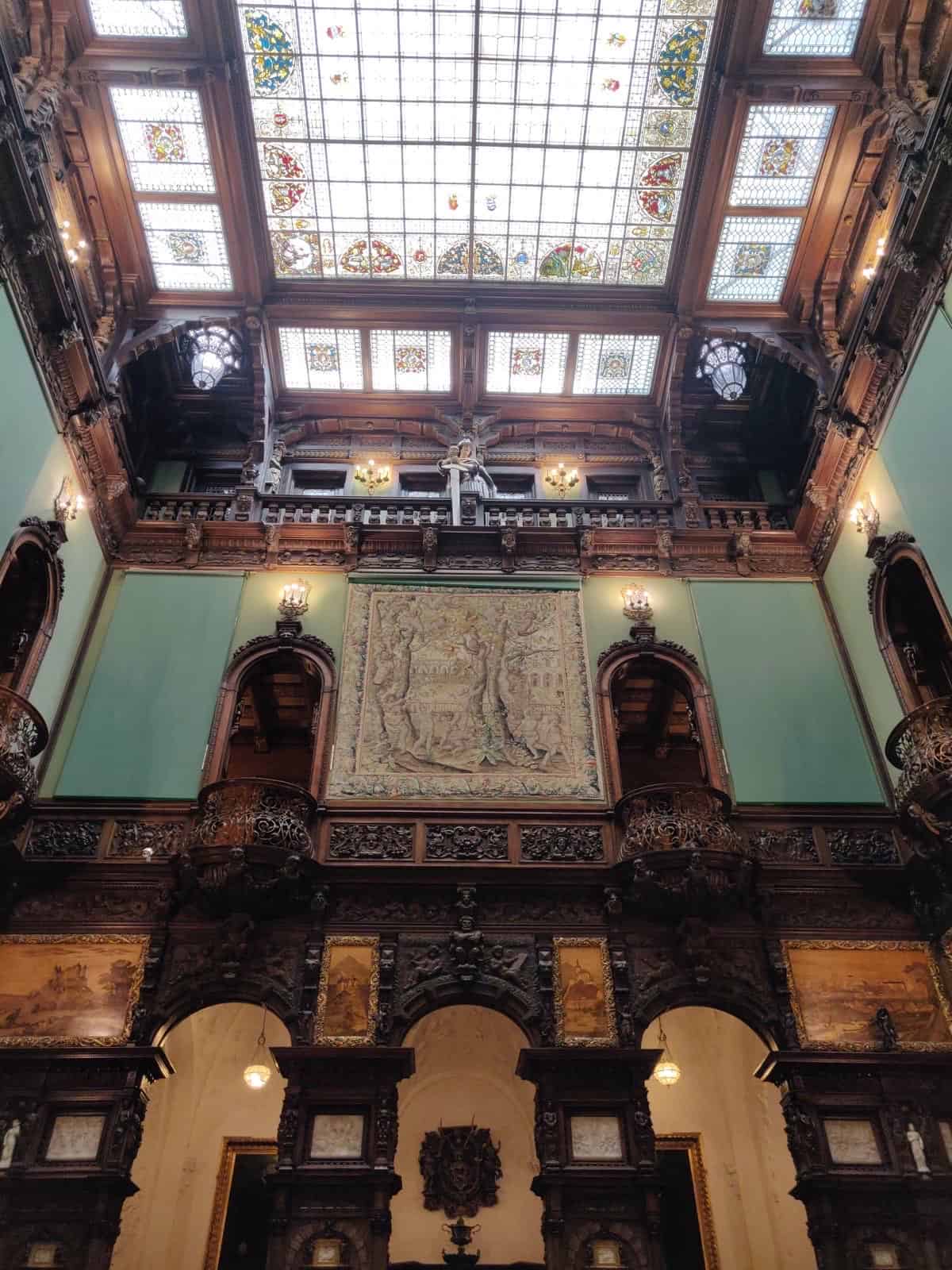
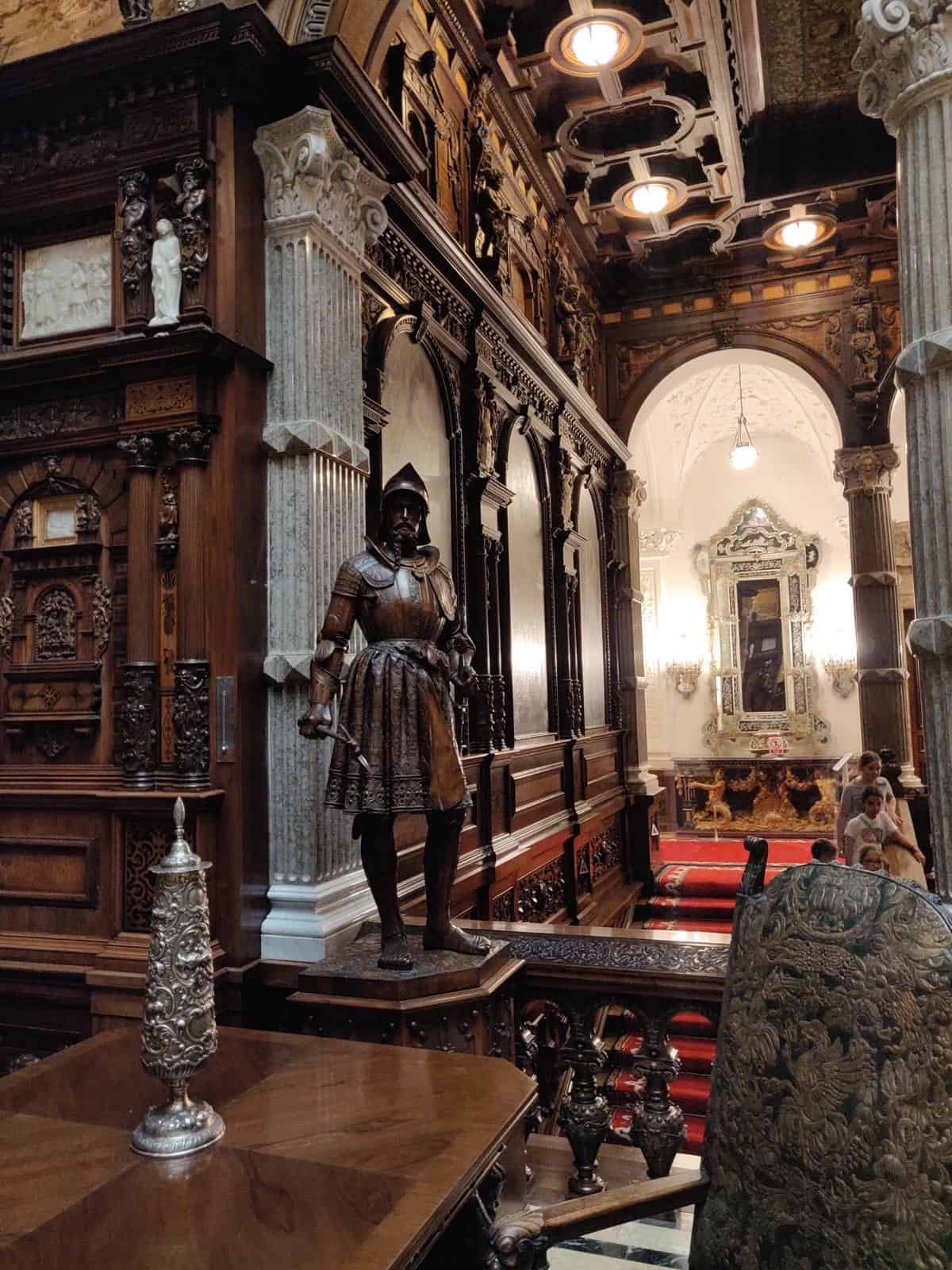



If those endless hours spent on Minecraft, building stately palaces with my brother with a cobbled blend of random architectural styles were to resemble anything in the real world, this was it: a true domestic Neuschwanstein.

Sinaia and Transylvanian goodbyes
Leaving the castle grounds, I wound my way down the hill along the touristed road. Just outside Peleș, I had picked up a basket of strawberries with blueberries sprinkled over the top, all arrayed in a woven straw basket. My mouth and fingertips were stained ever increasingly purple as I wandered down from the castles into Sinaia.
Sinaia actually marks my entry into the historic region of Wallachia; though the boundary between historic Transylvania and Wallachia is rather nebulous, it seemed fitting that both regions of such import should share in this expanse of rich valley.

I sat at a café in town, having emerged from my hill descent by the main park in the north of town, and then headed south to my pension. That evening, on the recommendation of locals, I walked to a family run restaurant to the east (up the hill) of town serving Magyar food. I selected the spiced pork knuckle and cabbage salad off the menu, and, when the food arrived, the waiter – who before had been silent owing to the lack of a common language between us – suddenly found his voice: “I am jealous!” he said, in cheery English.
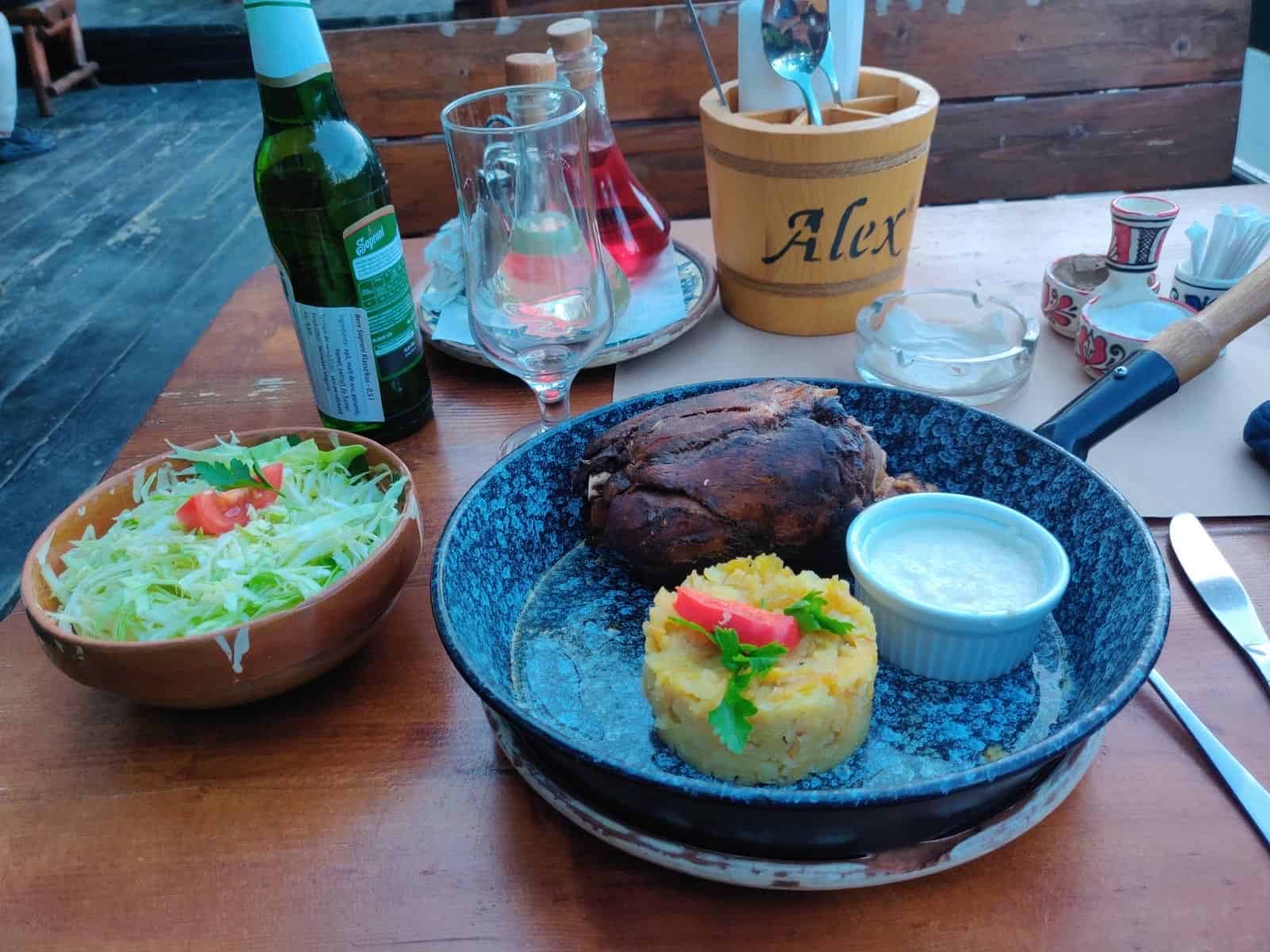
The Capital in the offing
The following days, I slowly descended from the higher regions of the Prahova valley. I headed out of Sinaia the next morning, where a mixture of the valley’s A road and other side roads eventually led me to a track that ran rather smoothly towards the south.
After passing through Câmpina, which marked my final night in the Prahova Valley, the mountains spanning the wings of the valley fell steadily away. That evening, as I entered the industrial city of Ploiești, the scent of nauseatingly sweet honeysuckle filled the air, complementing the rows of weathered Coke and Pepsi advertising boards which lay strewn in front of restaurants and pensions.
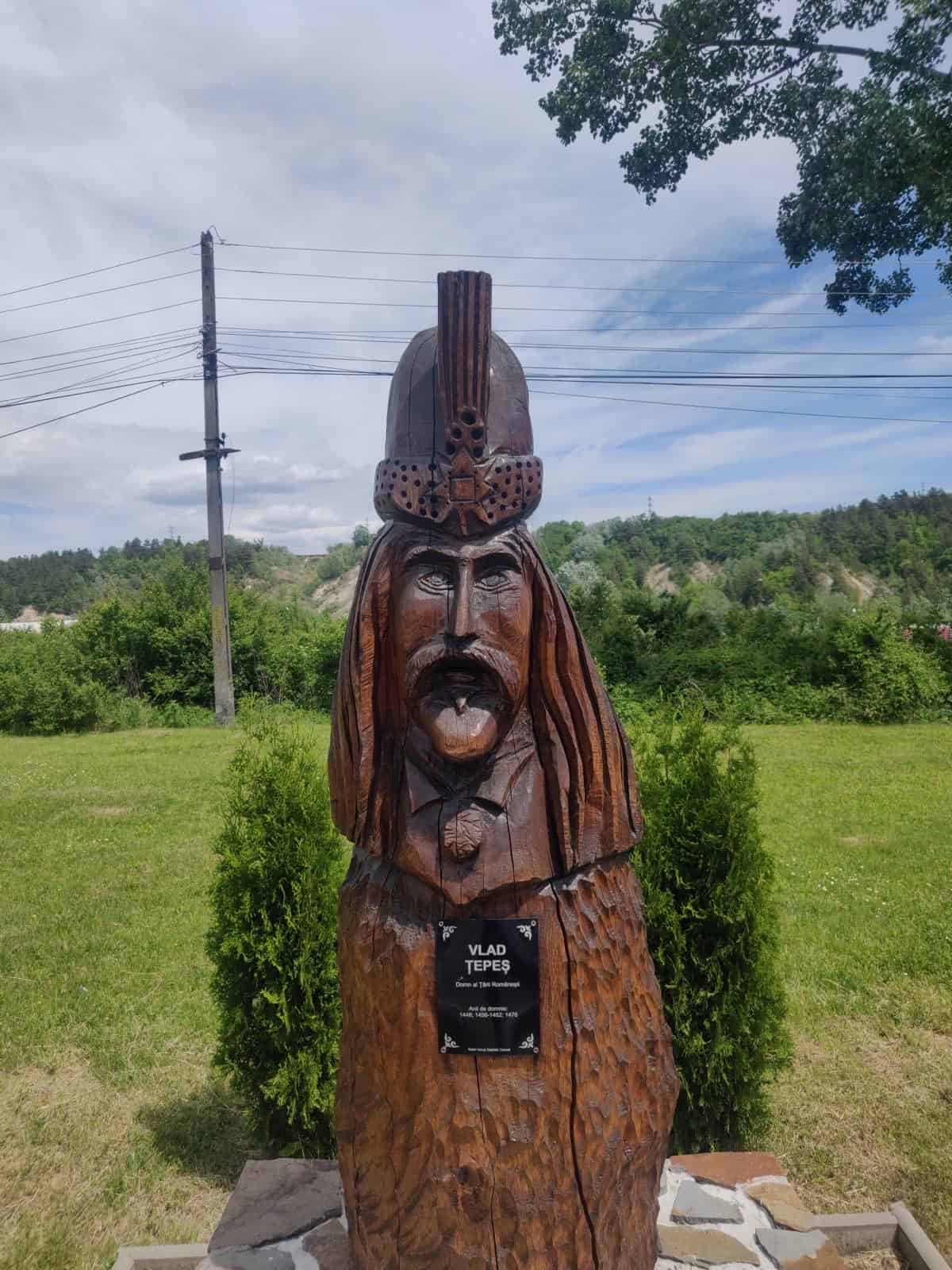
For several weeks, Transylvania had been my world; I had grown ever more infatuated with its mountains, forests, and rivers, just as I had its people, lore, and vivid mesh of cultures. It seems to me that Transylvania is not only a region of the past and myth, where serfs and nobles wander plains filled with great beasts and vampiric figures, but also – most excitingly – a region of the future: a region not only of touristed natural beauty and historic significance, as it will undoubtedly increasingly be seen across the world, but also as a flourishing example of a community for so long rooted in the respect of different religions, the acknowledgment of alternative ways of life (though of course there is still improvement to be made in the case of the Romani), and the understanding of one’s place in the wider world — as part of one greater country, the existence of which is not seen as an inherent threat to its own unique identity. I would hazard that it will not be long until I return.
Sooner than I would have liked, and with little warning, I had exited the Prahova Valley, traded the realm of Transylvania for that of Wallachia, and begun the trans-plateau tromp, where, within a few days, I would soon be bearing down on Bucharest.

Oh wow!! I was transported into your shoes (you will need a new pair soon!) and I was a bit scared: Bears! But
you ambled on .. so brave and seem to have all that wildness to yourself! The photos are outstanding. You have done such a great job .. many of us will never go there, but it is so nice it exists! And we know it does because
of your excellent reporting of all things Romania to us!! Thank you!!
Thanks
[…] It’s been a while and you may have missed the most recent blog post. Never fear, you can find it here! […]